
- •Editorial Advisory Board
- •Table of Contents
- •Detailed Table of Contents
- •Preface
- •Applying Semantic Agents to Message Communication in E-Learning Environment
- •A Case Study on Scaffolding Adaptive Feedback within Virtual Learning Environments
- •Enhanced Speech-Enabled Tools for Intelligent and Mobile E-Learning Applications
- •Quasi-Facial Communication for Online Learning Using 3D Modeling Techniques
- •Using a User-Interactive QA System for Personalized E-Learning
- •A Methodology for Developing Learning Objects for Web Course Delivery
- •Compilation of References
- •About the Contributors
- •Index
181
Chapter 12
Quasi-Facial Communication for Online Learning Using 3D Modeling Techniques
Yushun Wang
Zhejiang University, China
Yueting Zhuang
Zhejiang University, China
ABSTRACT
Online interaction with 3D facial animation is an alternative way of face-to-face communication for distance education. 3D facial modeling is essential for virtual educational environments establishment. This article presents a novel 3D facial modeling solution that facilitates quasi-facial communication for online learning. Our algorithm builds 3D facial models from a single image, with support of a 3D face database. First from the image, we extract a set of feature points, which are then used to automatically estimate the head pose parameters using the 3D mean face in our database as a reference model. After the pose recovery, a similarity measurement function is proposed to locate the neighborhood for the given image in the 3D face database. The scope of neighborhood can be determined adaptively using our cross-validation algorithm. Furthermore, the individual 3D shape is synthesized by neighborhood interpolation. Texture mapping is achieved based on feature points. The experimental results show that our algorithm can robustly produce 3D facial models from images captured in various scenarios to enhance the lifelikeness in distant learning.
INTRODUCTION
Intraditionaleducation, face-to-facecommunica- tion is natural among students and teachers. The situation in virtual education (Chang, 2002) and e-learning (Zhuang & Liu, 2002) is different,
where facial interaction is not commonly used. Students using a computer-based learning system are likely to study alone with relatively little classmate support (Ou et al., 2000).
Online interaction with facial animation over the network is an alternative way of face-to-face
Copyright © 2010, IGI Global, distributing in print or electronic forms without written permission of IGI Global is prohibited.
Quasi-Facial Communication for Online Learning Using 3D Modeling Techniques
communication. 3D facial modeling is essential for building interactive virtual educational environments. In general, the use of facial modeling techniques in distance education mainly has three practical requirements. First, the method should be easily applied to new individuals. Second, it should require no exorbitant equipments and computation cost. Third, the results should be robust and realistic.
RELATED WORK
Thepioneeringworkoffacialmodelingforanimation was done by Parke (1972). Currently, there are several main streams of available solutions:
•Modeling by 3D scanners: Special equipments like 3D scanners can be used to capture the 3D shape of human heads. The data produced often need a lot of post-processing in order to reduce noise and fill the holes.
Besides, in order to animate 3D scanned models, the shape must also be combined with an animation structure, which can not be produced by the scanning process directly.
•Physical-basedmodeling:(Terzopoulos&
Waters, 1990; Kahler et al., 2002; Sifakis et al., 2005) One of the approaches to facial modeling is to approximate the anatomical structures of the face, that is, skull, muscles and skin. The animation from physical models reflects the underlying tissue stresses.
Due to the complex topology of human faces, it requires tedious tuning to model a new individual’s face.
•Feature-points-based modeling: (Pighin et al., 1998; Lee & Magnenat-Thalmann,
2000) Starting with several images or a 3D scan of a new individual, the generic model is deformed by the extracted facial feature points. Images are ubiquitous nowadays and a good source for facial modeling. In
order to recover the 3D information, it needs orthogonal pair or more uncalibrated images.
•Example-based modeling: Blanz and Vetter (1999) propose a method named morphable model, which builds new faces by a linear combination of examples. Their work can be applied to reanimating faces in images and videos (Blanz, 2003; Vlasic et al., 2005). Supported by the examples, the input constraints can be released to only one image of the individual to generate plausible 3D results. The convergence process takes nearly an hour on SGI workstation, which limits its applications.
OUR APPROACH
The example-based approaches work well when thereareasmallnumberofexamples.Theiteration process converges and gets reasonable synthetic shapes and textures. However, as the number of examples increases, the structure of the 3D face space becomes more complicated and the global Euclideandistancemeasurementbecomesinvalid. The iterative optimization algorithms such as gradient descent need a lot of time to converge and easily get lost or trapped in local minimums. On the other side, in order to span a complete range of facial shapes, a large set of examples needs to be built. Due to the development of 3D scanners and the demand of realistic facial modeling and animation, the number of examples may increase dramatically.Forinstance,thefacialanimationsof
Gollum in the feature film The Two Towers employed 675 example shapes (Fordham, 2003).
In order to solve this problem, we introduce nonlinear learning algorithm from dimension reductions (Roweis & Saul, 2000), which maps its inputs into a single global coordinate system of lower dimensionality, and its optimizations— though capable of generating highly nonlinear embeddings—do not involve local minima. The
182
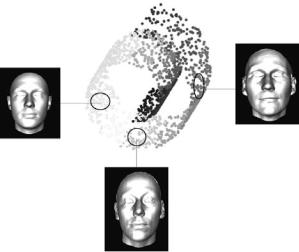
Quasi-Facial Communication for Online Learning Using 3D Modeling Techniques
Figure 1. 3D faces lie on a high dimensional manifold, where each 3D face can be reconstructed by its neighbors. The properly selected neighborhood will preserve the most salient features of the reconstructed 3D shape.
idea is based on simple geometric intuitions that the data points can be locally interpolated by its neighbors on a small piece of manifold patch. An n dimensional manifold is a topological space that is locally Euclidean (i.e., around every point, there is a neighborhood that is topologically the same as the open unit ball in Rn). The intuition is that if we can find the neighbors in the 3D face space for the given image, the synthesis process could be accelerated, as shown in Figure 1.
Based on the analysis above, we present a fast and efficient methodology to exploit a single photograph to get an animatable face model in a virtual world. The approach falls into the category of example-based modeling, but also we extend this method by exploring the nonlinearity of 3D faces. Our algorithm efficiently finds the neighborhood for a given image in the 3D face space and synthesizes new faces using neighborhood interpolation.
Algorithm Overview
As shown in Figure 2, our system takes a single image as input, and outputs a textured 3D face.
Ouralgorithmcanbesummarizedintofivesteps. Thefirstthreestepsdirectlyrelatetothenonlinear analysis, that is, locally embedding of the 3D face space, which provide a foundation for neighborhood interpolation. The latter two steps are about the synthesis of new faces:
•Step 1: Given a frontal face image, a set of pre-defined feature points is extracted;
•Step 2: Based on the feature points and a reference model, the head pose in the image is recovered automatically;
•Step3:Theimagefindsitsneighborsinthe space of 3D faces by our similarity measurement;
•Step 4: The 3D shape for the image is constructed by the neighborhood-based optimization;
•Step 5: Texture coordinates are generated on the basis of the feature points to produce texture mapping of the model.
The rest of the article is organized as follows. In the next section, we describe the locally embedding analysis of 3D face space. Then the
183
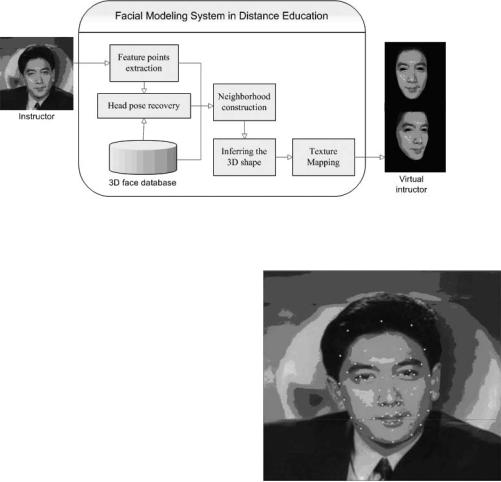
Quasi-Facial Communication for Online Learning Using 3D Modeling Techniques
Figure 2. Overview of our 3D facial modeling system, which takes a single image as an input and gives a 3D textured model as output
neighborhood interpolation algorithm for the synthesis of new faces is presented, followed by the experimental results. Finally, we conclude this article and discuss some ideas for future work.
LOCALITY OF 3D FACE SPACE
In order to find the right position in the space of 3D faces for a given 2D image, a similarity measurement is needed. We employ the feature points on both images and face models as the input parameters for similarity measurement after an automatic head pose recovery.
Definition of Feature Points
MPEG-4 employs 84 feature points (Facial
Definition Parameters, FDP) (Ostermann, 1998) to define a head model. For creating a standard conformingface,thesetoffacialdefinitionpoints used in our article are derived from the MPEG-4 FDP. We exploit 58 feature points, as shown in
Figure3,todefinethefrontalfacialfeatures.The feature points of a given image can be extracted manually or automatically.
The 3D models used in this article are complete models with necks and ears besides the facial mesh. They are all preprocessed and in corre-
Figure 3. Standard-conforming feature points definition
spondence. The definition of the feature vertices on a reference model will also be made on other examples from their correspondence. The feature points define a bounding box in which the part of mesh is our volume of interest from the facial animation point of view. During the operations of facial modeling and texture mapping, only the mesh in the bounding box is rendered.
Head Pose Recovery
The head pose of the image needs to be determined before calculating similarity. Various methods have been reported in the scenario of
184

Quasi-Facial Communication for Online Learning Using 3D Modeling Techniques
Figure 4. Feature points used to estimate the head pose of the image (right) with a 3D face example (left)
image sequences (Zhu & Ji, 2004) or range data (Malassiotis & Strintzis, 2005). This article proposes an efficient solution for pose recovery, whichhasthreecharacteristics.First,withsupport of a 3D face example, we can recover the pose parameters from a single fronto-parallel image. Thereferencemodelemployedhereisthe3Dmean face in our database for its generality. Second, similarity transformation parameters are used, that is, the parameters to be estimated are rotation R, translation t, and scaling s. Third, using least squares estimation, the similarity transformation parameterscanbecalculatedefficientlybymatrix operations.
Our system chooses the feature points on eyes and mouth to estimate pose, for they are nearly on a plane. These 2D feature points on fronto-parallel images can be thought as on xoy plane in the 3D space. Then the problem of pose estimation is translated to the problem of similarity transformation parameters estimation between two point patterns, as shown in Figure 4. We use least squares estimation to minimize a cost function:
C(R,t, s) = |
1 ∑ pi -(sRvi +t) 2 |
(1) |
|
n |
|
n i=1
Figure5.Estimatedheadposeparametersapplied to the 3D face example
where {pi =(xi, yi, 0)} is a set of feature points on image, {vi = (xi, yi, zi)} is a set of feature vertices on the 3D model, R: rotation, t: translation:, and s: scaling are the 3D similarity transformation parameters, n is the number of feature points and vertices.MinimizingthecostfunctioninEquation 1 will give the transformation parameters.
The estimated transformation parameters for Figure 4 are calculated and applied to the 3D model, as shown in Figure 5.
185
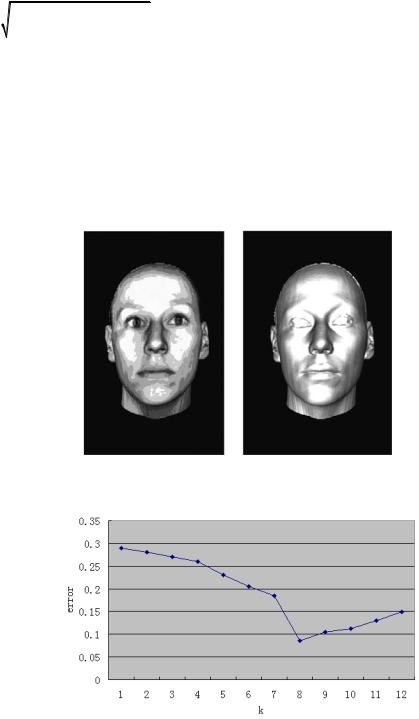
Quasi-Facial Communication for Online Learning Using 3D Modeling Techniques
Neighborhood Construction
After the head pose estimation, the distance between the image and the 3D examples can be written as:
n |
2 |
|
||
D(I, M j ) = ∑ |
|
pi - projxoy (sRvi +t) |
(2) |
|
i=1 |
|
|
|
|
where I is the input image, Mj is the jth example in 3D face space, and projxoy is a mapping function to choose (x, y) from (x, y, z).
Once the distance function is determined, the only problem in the manifold analysis is how to choose the boundary of neighborhood. K nearest
neighbors (k-NN) and e-neighborhood: Ne(I) = {Mj | D(I, Mj) ≤ e} are two strategies for selecting the size of local neighborhood. Our system combines k-NN and cross-validation to analyze and determine the value of k adaptively. We keep some 3D examples outside the database for crossvalidation. As shown in Figure 6, the image on the left is input to our system for 3D reconstruction. Thereconstructionresultiscomparedwiththereal 3D data and gets a validation error. By testing the relationship between the error and the value of k, the optimum value of k is determined adaptively, as shown in Figure 7. The reconstruction error fallstoitsminimumwheretheneighborsrepresent most of the given example’s salient features. As
Figure 6. Extra image and 3D shape of an individual who is not in the database for cross-validation
Figure 7. The cross-validation result to choose k adaptively
186
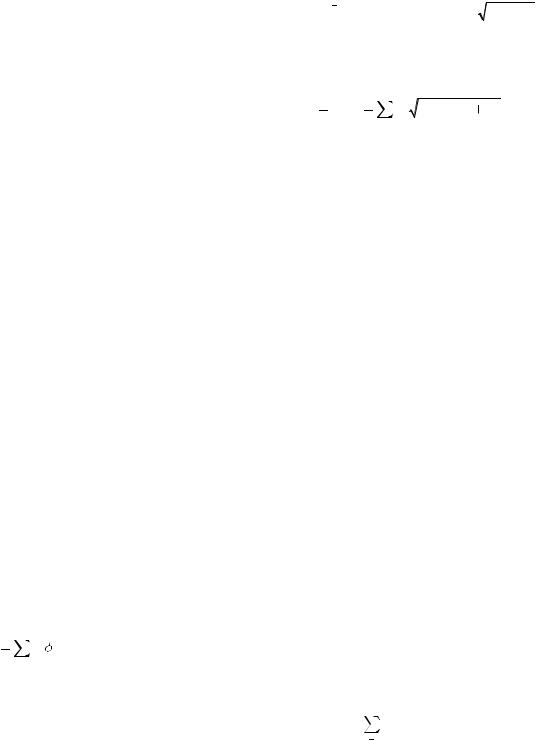
Quasi-Facial Communication for Online Learning Using 3D Modeling Techniques
the number of k exceeds some value, the salient features tend to be smoothed out by averaging too many examples. Several such validation examples may be processed and the value of k is chosen by averaging these validation optimums. The properly selected neighborhood will preserve the most salient depth features of the individuals. This idea could also be applied to e-neighborhood, where the value of ecan be chosen via validation by extra examples.
SYNTHESIS OF NEW FACES
Once the neighborhood for a given image is found, optimization techniques can be used to infer the 3D shape.
Inferring 3D Shapes by
Neighborhood Interpolation
We construct a function that maps the 2D pixel positions P = {pi} to the 3D vertex coordinates V = {vi}. Constructing such a function can be regarded as an interpolation or approximation problem, which solves a problem of approximating a continuous multivariate function f(x) by an approximate function F(x, c) with an appropriate
choice of parameter set c where x and c are real vectors (x = x1, x2, ..., xn and c = c1, c2, ..., ck).
The family of radial basis functions (RBF) is well known for its power to approximate high dimensional smooth surfaces and it is often used in model fitting [9]. The network of RBF to infer the 3D shape of a given image is:
k |
|
|
vj |
cji (D(I, Mi )) |
(3) |
i |
1 |
|
where I is the input image represented by feature points, Mi is the ith 3D model in its neighborhood, D(I, Mi) is the distance function described in Equation 2, k is the number of k-NN neighbors, cji denotes the parameters to be learned , j represents the jth element in the output vector, φ(r) is
radially symmetric basis functions. Examples
of basisr functions are Gaussian functions φ(r) = e ( c )2, multi-quadrics φ(r) = (r2  c2 ) and thin
c2 ) and thin
plate splines φ(r) = r2 log r with a linear term added. Plugging the Hardy basis function into Equation 3 results in:
v |
|
F |
k |
c |
|
D(I, M |
)2 |
s 2 |
(4) |
j |
(I ) |
ji |
|||||||
|
j |
i |
1 |
i |
|
i |
|
||
|
|
|
|
|
|
|
|
where si =min(D(I, Mi))isthestiffnesscoefficient for balancing the scope of neighborhood.
Substituting the k pairs of neighborhood training data (p, v) into Equation 4 results in a linear system of k equations, where p is the vector concatenating all the elements of projxoy=(sRvi + t) and v is the vector concatenating all the elements of vertex coordinates on the ith 3D model. Solving the linear system yields:
c = H-1v |
(5) |
c = (H + lI)-1v |
(6) |
where l=0.01 is a small disturbing factor determined empirically to decrease the impact of noise and I here is the identity matrix.
Texture Coordinates Extraction
Based on the feature points of the image, the texture coordinates can be interpolated to get texture mapping. Given a set of corresponding feature vertices on the 3D model and texture coordinates, the in-between vertices can get their texture coordinates via scattered data interpolation. We use the method similar to one in the previous subsection, except that the input of the RBF system is the 3D vertex and the output is the corresponding texture coordinates.
t = F(v) = n |
ci φ(||v - vi||) |
(7) |
i |
1 |
|
where v is the input 3D vertex, viis the ith feature vertex, t is the texture coordinates.
187
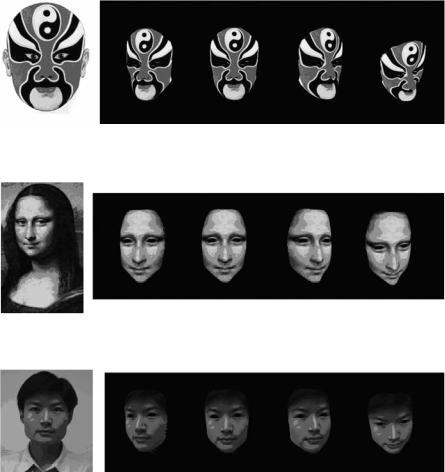
Quasi-Facial Communication for Online Learning Using 3D Modeling Techniques
EXPERImENTS
The 3D face database was provided by the MaxPlanck Institute for Biological Cybernetics in Tuebingen, Germany. The 3D scanned faces in the database provide a good start point for our supportive database. We have aligned all the 3D models with an animatable model and reduced its vertex density. The eyes and mouth areas were excided for animation purpose. Besides, we added extra examples to the database by face modeling software. After that, the database consists of 200 heads each with 6K vertices.
In order to test our techniques, we have implemented a prototype system using Visual C++ and
Matlab. We have tested our system by modeling a traditional Beijing opera face painting (Figure 8). We also applied our method to paintings such as Mona Lisa by Leonardo (Figure 9). We reconstructed the face models from color images taken by us (Figure 10), black and white images from Cohn-Kanade (Kanade et al., 2000) facial expression database (Figure 11) or images taken under arbitrary unknown conditions (Figure 12). We manually marked the feature points and the system takes approximately one second to reconstruct the 3D model with texture mapping. Although reconstructing the true 3D shape and texturefromasingleimageisanunder-determined problem, 3D face models built by our system look
Figure 8. The 3D modeling of a traditional Beijing opera face painting
Figure 9. The 3D modeling of Mona Lisa
Figure 10. An example of 3D modeling of image taken by the authors
188

Quasi-Facial Communication for Online Learning Using 3D Modeling Techniques
Figure 11. 3D modeling of a black and white image from an open face database
Figure 12. Another facial modeling example
Figure 13. Quasi-facial online learning system
vivid from the frontal viewpoint and natural from other viewpoints.
Besides, we have implemented a prototype of the quasi-facial online learning system over college intranet, as shown in Figure 13. The 3D modeling techniques facilitate the quasi face-to- face communications. The virtual instructor can perform facial expressions and oral communications, which will be supportive for an effective distant learning atmosphere.
CONCLUSION AND FUTURE WORK
This article proposes a novel approach to 3D facial modeling from a single image. In this algorithm, we measure the distance between the input image and the 3D models after estimating similarity transformation. Neighborhood interpolation is used to find the optimum of the 3D shape to preserve salient features. Furthermore, the image is mapped onto the synthesized model as texture.
189
Quasi-Facial Communication for Online Learning Using 3D Modeling Techniques
Vivid 3D models and animation can be produced from a single image through our system.
Our algorithm only needs matrix operations instead of an iterative process to find optimums. Therefore,itisefficientformanyapplications,such as teleconference, digital entertainment and video encoding. The application in distance learning is very encouraging for supporting a vivid online learning environment.
There are several directions of improvement in the future. The inner properties of the face space need to be further explored in order to synthesize new faces efficiently and accurately. Currently, the texture mapping just exploits the colors on the image that reflect the lighting conditions under which it was taken. Relighting techniques should be developed for integrating our facial model with the virtual environment. Furthermore, the wrinkles and detailed textures have not been properly tackledintheexistingtechniques.Theseproblems ought to be considered in future work.
ACKNOWLEDGmENT
This work is supported by the National Natural Science Foundation of China (No.60525108, No.60533090), 973 Program (2002CB312101), Science and Technology Project of Zhejiang Province (2005C13032, 2005C11001-05). Yushun Wang would like to thank Ming Zhao and Feng Liu for suggestions on revising the article.
REFERENCE
Blanz,V.,&Vetter,T.(1999).Amorphablemodel for the synthesis of 3D faces. Proceedings of The Siggraph 99 conference (pp. 187-194). New York: ACM Press.
Blanz,V.,Basso,C.,Poggio,T.,&Vetter.T.(2003).
Reanimatingfacesinimagesandvideo.Computer Graphics Forum, 22(3), EUROGRAPHICS 2003
(pp. 641-650). Granada, Spain.
Chang, S.-K. (2002). A growing book for distance learning. Proceedings of the First International Conference on Advances in Web-Based Learning (ICWL’02) (pp. 3-18). Hong Kong, China.
Fordham, J. (2003). Middle earth strikes back.
Cinefex, 92, 71-142.
Kahler,K.,Haber,J.,Yamauchi,H.,&Seidel,H.-
P. (2002). Head shop: Generating animated head models with anatomical structure. Proceedings of The ACM SIGGRAPH Symposium on Computer Animation (pp. 55-64).
Kanade, T., Cohn, J., & Tian Y. (2000). Comprehensive database for facial expression analysis.
Proceedings of FG (pp. 46-53).
Lee, W., & Magnenat-Thalmann, N. (2000). Fast head modeling for animation. Journal of Image and Vision Computing, 18(4), 355-364. Elsevier Science.
Malassiotis, S., & Strintzis, M. (2005) Robust real-time 3D head pose estimation from range data. Pattern Recognition, 38(8), 1153-1165.
Ostermann,J.(1998).Animationofsyntheticfaces in MPEG-4. Computer Animation, 49-51.
Ou, K.-L., Chen, G.-D., Liu, C.-C., &Liu, B.-J.
(2000). Instructional instruments for Web group learning systems: The grouping, intervention, and strategy. Proceedings of the 5th annual SIGCSE/ SIGCUE ITiCSE conference on Innovation and technology in computer science education (pp. 69-72). Helsinki, Finland.
Parke, F. (1972). Computer-generated animation of faces. Proceedings of the ACM annual conference.
190
Quasi-Facial Communication for Online Learning Using 3D Modeling Techniques
Pighin, F., Hecker, J., Lischinski, D., Szeliski,
R., & Salesin, D. (1998). Synthesizing realistic facial expressions from photographs. Siggraph proceedings (pp. 75-84).
Roweis, S., & Saul. L. (2000). Nonlinear dimensionality reduction by locally linear embedding.
Science, 290, 2323-2326.
Sifakis, E., Neverov, I., & Fedkiw, R. (2005).
Automatic determination of facial muscle activations from sparse motion capture marker data.
SIGGRAPH 2005, ACM TOG 24 (pp. 417-425).
Terzopoulos,D.,&Waters,K.(1990).Physicallybased facial modelling, analysis, and animation.
Journal of Visualization and Computer Animation, 1(2), 73-80.
Vlasic, D., Brand, M., Pfister, H., & Popovic, J.
(2005). Face transfer with multi-linear models.
ACM Transactions on Graphics (TOG), 24(3), 426-433.
Zhu, Z., & Ji, Q. (2004). Real-time 3D face pose trackingfromanuncalibratedcamera.Conference on Computer Vision and Pattern Recognition Workshop (CVPRW’04), 5, 73.
Zhuang,Y.,&Liu,X.(2002).Multimediaknowledge exploitation for e-Learning: Some enabling techniques. Proceedings of the First International Conference on Advances in Web-Based Learning (ICWL’02), LNCS 2436 (pp. 411-422). Hong Kong, China.
This work was previously published in International Journal of Distance Education Technologies, Vol. 6, Issue 1, edited by S. Chang; T. Shih, pp. 67-78, copyright 2008 by IGI Publishing (an imprint of IGI Global).
191
192
Chapter 13
Enhancing Skills of Application
Software via Web-Enabled
Problem-Based Learning
and Self-Regulated Learning:
An Exploratory Study
Pei-Di Shen
Ming Chuan University, Taiwan
Tsang-Hsiung Lee
National Chengchi University, Taiwan
Chia-Wen Tsai
Ming Chuan University, Taiwan
ABSTRACT
The computer software education in vocational schools in Taiwan can hardly be deemed as effective. To increase students’ learning motivation and develop practical skills, innovative learning designs such as problem-based learning(PBL) and self-regulatedlearning(SRL)areontrialinthisspecificcontext.Wecon- ducted a series of quasi-experiments to examine effects of these designs mediated by a web-based learning environment. Two classes of 106 freshmen in a semester course at Institute of Technology in Taiwan were chosen for this empirical study. Result sreveal that effects of web-enabled PBL, web-enabled SRL, and their combinations,onstudents’skillsofapplicationsoftwarehavesignificantdifferences.Theimplicationsofthis study are also discussed.
Copyright © 2010, IGI Global, distributing in print or electronic forms without written permission of IGI Global is prohibited.
Enhancing Skills of Application Software via Web-Enabled Problem-Based Learning
INTRODUCTION
Professionals with a vocational degree represent a major portion of the work force in Taiwan. Vocational education is highly competitive in that it must attract enough student enrollments in the face of a continually decreasing birthrate and a rapidly increasing number of schools. Students in theseschoolstendtohavelowerlevelsofacademic achievement. They spend more time on part-time jobs and do not get involved in their schoolwork adequately. They also care less about their grades. Teaching in such a context, particularly teaching the curriculum of application software, is a great challenge to most educators.
No one doubts the guiding principles of practical applications in the vocational education in Taiwan (Tai, Chen, & Lai, 2003). However, most teaching and learning efforts in this area have been devoted to helping students pass written tests, and, thus, receiving awards or official certificates. Schools, facing the high pressure of market competition, often emphasize the proportion of students awarded such certificates before they graduate instead of quality education. This materialistic aim puts students’ attention less on mastering application software and more on preparing for tests through memorization. Consequently, a student who has passed the examination may still be unable to apply what was learned in school, and worse, lack motivation to learn more in the future.
The courses in application software traditionally emphasize memorization by applying short, disjointed, lack-of-context examples. There is a wide gap between what is learned in school and what is required in the workplace (Wu, 2000). In this regard, the computer software education in vocational schools in Taiwan can hardly be deemed as effective. In order to increase students’ learning motivation and develop practical skills, problem-based learning (PBL) is considered to be the most appropriate. PBL uses real-world, simulated, contextualized problems in practice
to motivate, focus, and initiate content learning and skill development (Boud & Feletti, 1991;
Bruer, 1993; Williams, 1993). We believe that PBL could help low-academic-achievement students to develop practical skills of application software through online courses.
Web-based instruction seems to be an ideal learningenvironmentbecausestudentscanaccess an almost-unlimited amount of information and apply it in multiple ways (Kauffman, 2004). However, implementing e-learning for low-academic- achievement students inevitably runs high risks. For instance, Internet addiction is quite common among low-academic-achievement students. When students enter the traditional classroom, they are used to logging on to MSN Web Messen- gerandcheckingtheire-mailfirst.Manystudents like to chat with each other frequently via MSN Web Messenger, even though they are in the same classroom.TheymightbrowseshoppingWebsites, even while a teacher is lecturing in the classroom. Thus, the teacher has to disconnect the network several times in his classroom to focus students’ attention. It is even more difficult for students to concentrate on online learning because of this addiction to the Internet and a lack of on-the-spot teacher monitoring. To respond to this challenge, we propose an approach that can help students regulate their learning in a better way.
Success in online courses often depends on students’ abilities to successfully direct their own learning efforts (Cennamo, Ross, & Rogers, 2002). It is very critical to develop students’ self-regulationoflearningbeforeprovidingonline courses to them. In web-based learning environments, physical absence of an instructor and increased responsibility of learners to effectively engageinlearningtasksmaypresentdifficulties, particularly those with low self-regulatory skills
(Dabbagh&Kitsantas,2005).Studentmotivation may benefit from Web-based instruction with self-regulated learning (SRL) strategies. Students in the online environment, equipped with SRL competence, become more responsible for their
193
Enhancing Skills of Application Software via Web-Enabled Problem-Based Learning
learningandmoreintrinsicallyorientated(Chang, 2005).Soself-regulationisimportant,particularly while learning in World-Wide-Web-supported environments (Winnips, 2000).
Although researchers have consistently shown that self-regulation helps high achievers reach theirpotential(Risemberg&Zimmerman,1992), it also makes a difference between failure and successforlowachievers(Borkowski&Thorpe,
1994). However, there has been relatively little empirical research on students’ SRL with such complextechnology-basedlearningenvironments
(Azevedo&Cromley,2004).Therefore,thisstudy applies SRL in this study to help vocational school students (particularly the low achievers) concentrate on their learning, leave time for learning after their part-time jobs, and furthermore, take responsibility for their learning.
There are few studies that have discussed effective online teaching methods for low academic achievers. In this area, the restructuring and translation of traditional computer software courses into e-learning has seldom been documented. Thus, this study redesigns a course in applicationsoftwareto integrate innovative teaching methods and learning technologies to help students learn and apply what they have learned.
This study specifically explores potential effects of Web-based PBL and SRL on the development of low-academic-achievement students’ skills in using packaged software.
AUTHENTIC ASSESSmENT
The traditional teaching approach regarded learners as passive recipients of information. Memorization of the content lectured by the teacher was the main goal of the instructional process. The assessment approach that accompanied this instructional approach was mainly operationalized by the so-called objective test, often standardized and with a true/false or a multiple-choice item format. Such assessments mostly do not seem
to assess higher-order cognitive skills, such as problem solving, critical thinking, and reasoning
(Segers, Dochy, & De Corte, 1999).
However, the objective tests are often given, even in computer software education. They could notevaluatestudents’practicalskills,butalsolimit thepotentialapplication.Twoinnovativeandpractical teaching methods are applied in this study, so the traditional measurement is not appropriate to assess students’ learning, particular in computer software education. More appropriate assessment methods for PBL would include reports, practical examinations, construction of concept maps, peerassessment,ororalpresentations(Sonmez&
Lee, 2003). In this regard, we measure students’ skills of application software according to the correctness and completeness of their problem solving and artistry of their design instead of the memorization. The way we assess students’ improvement in skills of application software is described in the “Measures” section.
PROBLEm-BASED LEARNING
Problem-based learning (PBL) is a teaching method that may engage students in authentic learning activities by using challenging problems in practice as a starting point, stimulus, and focus for learning (Barrows & Tamblyn, 1980; Boud, 1985;Barrows,1985,1986;Walton& Matthews, 1989;Boud&Feletti,1991).PBLpromotesstudent learning based on the need to solve problems. It not only emphasizes the learning in the subject area, but also provides opportunities for students to practice and apply knowledge and learned skills.
Davis and Harden (1999) indicate that PBL is one of the most effective teaching methods in recent 30 years. The probable reason is that the learning environment of PBL includes all kinds of factors currently known which can improve efficiency of learning, such as activity, cooperation, feedback, adaptability, and accountability.
194
Enhancing Skills of Application Software via Web-Enabled Problem-Based Learning
Albanese and Mitchell (1993) reveal that PBL helps students more in knowledge construction and reasoning skills compared with the traditional teachingapproach.PBLmayhelpstudentsachieve learning goals, such as professional reasoning; integration of scientific, academic, and professional knowledge; and lifelong learning skills (Dunlap, 2005).
Many Researchers examine PBL’s positive impact on knowledge and skill acquisition and transfer, problem solving, attitudes and opinions about courses and programs, measures of performance, and self-directed learning (Norman
& Schmidt, 1992; Albanese & Mitchell, 1993; Berkson, 1993; Vernon & Blake, 1993; Colliver,
2000; Davies, 2000). Furthermore, Polanco, Calderón, and Delgado (2004) point out that students in PBL groups attain significantly higher scores than students in a course from a control group composed of physics, mathematics and computer science.
In the domain of Information Science, Greening, Kay, Kingston, and Crawford (1996) consider that upper-level university students should have developedmanykey competencies.However,during teaching, they actually find many third-year studentsnothavingacquirednecessarycompetencies from information science curriculum. PBL, as an alternative teaching method, demonstrates that it helps to improve students’ key competencies. Yip (2001) points out that PBL can enhance competencies, both in professional and information systems education.
PBLisaflexibleapproach.Ithasdemonstrated its working well with both small teams and large groups. However there might be disagreement whether PBL will be as effective, or even possible, for online learning. In this regard, Chanlin and Chan (2004) examine the effects of PBL in a Web-based approach. Results reveal that students in the PBL treatment group perform better than those from the control group. Therefore, it can be summarized that, in a Web-enabled learning environment, the effects of problem-based learn-
ing on students’ skills of application software are positive, and higher than those without PBL.
SELF-REGULATED LEARNING
Zimmerman and Schunk (1989) define SRL in terms of self-generated thoughts, feelings, and actions,whicharesystematicallyorientedtowards attainment of students’ own goals. SRL is also defined as a learner’s intentional efforts to manage and direct complex learning activities and is composed of three primary components, namely cognitivestrategyuse,meta-cognitiveprocessing, and motivational beliefs (Kauffman, 2004).
Yang (1993) finds that students who are high self-regulatory skill users, as measured by a preexistingindex,scoresignificantlyhigherthan their counterparts, low self-regulatory skill users, regardless of the level of control. Characteristics attributed to self-regulated persons coincide with those attributed to high-performance, highcapacity students, as opposed to those with low performance (or learning disabilities), who show a deficit in these variables (Roces & González Torres, 1998; Zimmerman, 1998; Reyero &
Tourón, 2003).
Zimmerman and Martinez-Pons (1986) point outthatstudents’frequencyofself-regulatedstrat- egy use predicts a substantial amount of variance in their achievement test scores. Nota, Soresi, and Zimmerman (2004) indicate that the cognitive self-regulation strategy of organizing and transforming proves to be a significant predictor of the students’ course grades in mathematics and technical subjects of high school, their subsequent average course grades, and examinations passed at the university.
AsfortheeffectsofSRLoncomputersoftware, Bielaczyc, Pirolli, and Brown (1995) incorporate self-explanation and self-regulation strategies in the attainment of the cognitive skill of computer programming.Theyfindthattheirtreatmentgroup, which incorporates the self-regulation strategies
195
Enhancing Skills of Application Software via Web-Enabled Problem-Based Learning
of self-monitoring and clarifying comprehension failures in conjunction with self-explanation strategies, outperforms a control group that did not havethebenefitofinstructioninthesestrategies.
Their study implies that, in addition to knowledge acquisition strategies, students benefit from the incorporation of strategies which allow them to plan, monitor, and evaluate their understanding and strategy use (Bielaczyc, Pirolli, & Brown,
1995). In a similar vein, this study provides us an insight that SRL is appropriate to be applied in computer software education.
Researchers have consistently shown that self-regulation helps high achievers reach their potential(Risemberg&Zimmerman,1992).Italso makes a difference between failure and success for low achievers (Borkowski & Thorpe, 1994). Young (1996) identifies that low self-regulatory skillusersarefoundtoperformsignificantlylower in computer-based instruction that applied learner control of the sequencing. It is believed that SRL is effective to the low achievers, not only through face-to-face instruction, but also in computerbased or technology-based instruction. Learners who report more extensive use of SRL strategies show higher academic achievement than learners who use self-regulated learning strategies less often (Zimmerman & Martinez-Pons, 1986). In the same study, students’ achievement could be predicted with 93% accuracy from reported use of SRL strategies.
Web-enabled learning environment is an interactive network system consisting of a variety of functionstosupportavirtualclassroomtoenhance the quality of teaching and learning activities
(Poon, Low, & Yong, 2004). Students can access information at their convenience, are free to work at their own pace, and can revisit information that they find confusing and/or interesting (Lehman, Kauffman,White,Horn,&Bruning,2001).Nevertheless,providingstudentswithopportunitiesto integrate their knowledge through Web-enabled instruction may not be effective if they lack the skills needed to regulate their learning. Thus,
strategies that prepare students for the rigors of learning at a distance and increase the probability of retention and success must be put into practice (Chang, 2005). Winnips (2000) suggests that self-regulation is particularly important when learning in World-Wide-Web-supported environments. In other words, it is even more critical for students to transform into self-regulated learners in Web-enabled learning. Previous studies have established that self-regulated skills can help foster learning from any instructional method (Weinstein, 1989; Zimmerman, 1990; Lindner
& Harris, 1993; Ertmer, Newby, & MacDougall,
1996). To sum up, in the Web-enabled learning environment, effects of self-regulated learning on students’ skills of application software are positive and performance higher than those without SRL.
PROBLEm-BASED LEARNING AND
SELF-REGULATED LEARNING
In PBL, students work in collaborative groups to identify what they need to learn in order to solve problems. They engage in self-directed learning (SDL), apply knowledge they acquire to the problems, and reflect on what they have learned and the effectiveness of the strategies they have employed. That is, PBL is well-suited to help students become active learners as it situates learning in real-world problems and makes students responsible for their learning (HmeloSilver, 2004). PBL helps prepare students for lifelong learning by developing students’ ability forself-directed learningand theirmeta-cognitive awareness (Dunlap, 2005).
PBL is a task-based approach that teachers can apply to support development of SRL. If PBL activitiesaredesignedcarefullywithteacherswho provide appropriate modeling and scaffolding, they facilitate and necessitate SRL. PBL provides opportunities for self-directed learning by offering students choice, control of what to work on,
196
Enhancing Skills of Application Software via Web-Enabled Problem-Based Learning
how to work, and what products to generate. PBL facilitates SRL because it places responsibility on thestudentstodiscoverinformation, to coordinate actions and people, to monitor understanding, and to reach goals (Paris & Paris, 2001).
Hmelo-Silver (2004) points out that students’ approaches to learn from problems are different qualitatively because of their degree of self-regu- lation. Ertmer et al. (1996) conducts a qualitative study of how veterinary students learned from problems. Low self-regulated learners have difficultyinadaptingtothekindoflearningrequired in problem-based instruction. They fluctuate according to their perception of the value of learning from problems. High self-regulated students value learning from problems and tend to focus on the problem analysis and reflection process.
In contrast, low self-regulated students tend to focus on fact acquisition. Furthermore, the results of Ertmer et al. suggest that low self-regulated studentsmayhavedifficultyindealingwithSRL demands of a PBL curriculum.
Combined training with self-regulatory and problem-solving strategies is effective for enhancing self-regulatory competences in solving mathematical problems (Perels, Gürtler, &
Schmitz, 2005). However, there are very few studies that discuss the effects of PBL and SRL simultaneously, particularly through teaching Web sites. According to the literature reviewed , it is believed that the learning effect will be even stronger when teachers arouse students’ interest, lead them to apply their skills and knowledge to solve problems, and encourage them to selfregulate their learning.
In this research, we hypothesize that students focusing on the aspects of problem-based learning variant with self-regulated learning would gain more development on the skills of application software than students studying the task without these co-existing treatments. We also hypothesize that learning effects of PBL and non-SRL group or non-PBL and SRL group are better than non-PBL
and non-SRL group. That is, highest increase of development in skills of applying packaged software is expected in conditions wherein students are confronted with the situation of simulated problems and with self-regulated or self-directed learning style without teachers’ pressure. Therefore, we propose the following: in a Web-enabled learning environment, the effects of PBL and SRL intervention on students’ skills of application software are positive, and higher, than those without the combined intervention.
mETHODS
Participants
Participants in this study are 106 fresh students takingacompulsorycourseof‘PackagedSoftware and Application’ in an institute of technology in
Taiwan. None of them major in the field of information or computer technology. However, in an institutionfortechnological/vocationaleducation, practical applications of technology are guiding principles (Tai, et al, 2003). Students are expected to spend more time and efforts in mastering a variety of technological skills, as compared to those in universities in Taiwan.
Course Setting
The course under study is a semester-long, two- credit-hour class, targeted at first-year college students from different majors. Students solve a seriesofauthentictasksbyapplying Microsoft Office (including Word, Excel, and PowerPoint).
Experimental Design and Procedure
In this study we explore whether students in the “Packaged Software and Application” course enhance their skills of application software via e-learning. Based on feedback from earlier re-
197
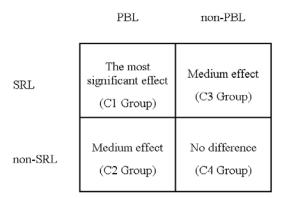
Enhancing Skills of Application Software via Web-Enabled Problem-Based Learning
search, we have re-designed the course and conducted a series of quasi-experiments to examine the effects of web-enabled PBL, SRL, and their combinations.
The experimental design is a 2 (PBL vs. nonPBL) × 2 (SRL vs. non-SRL) factorial pretest- post-test design (see Figure 1). Students from four groups solve the same task but in different learning conditions. Participants are randomly assigned to one of the four experimental conditions in such a way that each condition contains 24 to
30students.ThePBLandSRLgroup(C1,n=30), PBLandnon-SRLgroup(C2,n=25),non-PBLand SRL group (C3, n=24) are experimental groups, whilenon-PBLandnon-SRLgroup(C4,n=27)is the control group. The sample size in this study is large enough to be tested in statistics.
The course design in the present study consists of three subsequent modules: the Word module, the Excel module, and the PowerPoint module. A skill test is administered after the completion of each module. The first test is held during midterm examination (eighth week). The second test is held in the 13th week and the final one in the
16th week. A schedule of teaching of modules and skill tests is depicted in Figure 2.
In the beginning of a course, students are encouraged to adapt and learn via a course Web site. Teaching during this period is through a traditional classroom. A teacher records every sessionofthelecturefirstandthenconvertsthese lectures into a HTML file with flash, video, and voice. These HTML files are then loaded into the course Web site. Students can preview and review the course sessions on this course Web site. After three weeks, most of the coursework is moved onto the Web site. We help students to adapt to learning through the net and try lessen down a feeling of isolation. Within these three weeks, we adjust students’ learning gradually and smoothly.
Figure 1. Expected effects of variation in instructional methods
PBL Treatment
A teacher creates interesting, challenging, and authentic problem situations. In the first Word module, students are required to apply for a job as Marketing Assistant in an online-game company. They are required to design and then build autobiographies and resumes by applying skills of application software that they have just learned. In the Excel module, students play roles as if they are employed by this same software company, and a marketing manager asks them to compare expenses resulting from different distribution channels. They have to survey and then complete a worksheet with some graphs to contrast differences between channels. Additionally, they must come up with a recommendation regarding the best combination of channels. In the last module of PowerPoint, they are promoted as Marketing Managers of higher rank. They are asked to develop a business proposal for a new online game. They have to present this proposal withvisualaidstoconvincethe managing director to enter in to a market. Therefore, a persuasive PowerPoint presentation is built at this stage.
A teacher demonstrates first how they could approach the situation and solve the problem with the help of a Web-based multimedia application. In addition to the teaching of skills of application
198

Enhancing Skills of Application Software via Web-Enabled Problem-Based Learning
Figure 2. Schedule of three modules and skill tests
Word Module |
|
Excel Module |
|
PowerPoint |
(8 weeks) |
|
(5 weeks) |
|
Module |
|
|
(3 weeks) |
||
|
|
|
|
|
|
|
|
|
|
|
|
|
|
|
|
|
|
|
|
|
|
|
|
|
|
|
|
|
|
|
|
Week 1: |
|
|
|
Week 3: |
|
|
|
Week 8: |
|
|
|
Week 13: |
|
|
Week 16: |
|
|||
|
|
|
||||||||||||||||||
|
|
|
|
|||||||||||||||||
|
Participants |
|
|
|
The course is |
|
|
A Word |
|
|
|
An Excel |
|
|
A PowerPoint |
|
||||
|
are divided |
|
|
|
completely |
|
|
Test |
|
|
|
Test |
|
|
Test |
|
||||
|
into 4 groups |
|
|
|
moved to the |
|
|
|
|
|
|
|
|
|
|
|
|
|
|
|
|
and pretested |
|
|
|
website |
|
|
|
|
|
|
|
|
|
|
|
|
|
|
|
|
|
|
|
|
|
|
|
|
|
|
|
|
|
|
|
|
|
|
|
|
|
|
|
|
|
|
|
|
|
|
|
|
|
|
|
|
|
|
|
|
|
software, similar situations and related applications are also discussed in the class. Latter, the teacher guides students in constructing their own models of problem-solving.
SRL Treatment
There is a SRL group in each class. Two SRL groups from the PBL class and non-PBL class are gathered in a classroom and a two-hour lecture is delivered discussing how to manage study time and regulate their learning. The lecture is given in an after-school course. Content of this SRL course is composed of following four processes addressed by Zimmerman, Bonner and Kovach (1996), that is,
•Self-evaluation and monitoring,
•Goal-setting and strategy planning,
•Strategy implementation and monitoring
•Monitoring of the outcome of strategy.
Students are taught how to implement these four processes to become more regulated learners.
In addition to the two-hour lecture, students in SRL groups are required to prepare and read the
textbook regularly before classes, and to review or practice the skills of application software they have learned after school. They are also required to record their learning behavior every week. Data is recorded on the course Web site instead of their notebooks in order to prevent falsification of records. A teacher cursorily examines students’ records.
Treatments in four groups are illustrated and compared in Table 1.
measures
To examine levels of change manipulated by variations in experimental conditions, we first measured students’ skills of application software as a baseline before they entered the class. In the first week, students complete three Word documents as a pretest. We choose Microsoft Word for the pretest because almost every student in Taiwan learns Word before he learns any other software package.
The pretest grades show that computer skills of almost all are low. None of the participants are able to answer any of the pretest questions correctly. This confirms that all participants in the four groups had a little knowledge or a skill of software package. The difference in students’ skills of application software at the beginning
199
Enhancing Skills of Application Software via Web-Enabled Problem-Based Learning
Table 1. Teaching and learning activities in different experimental groups
Group |
Teaching Activities |
Learning Activities |
|
|
|
C1 |
A teacher… |
Students… |
|
•demonstrateshowtosolveauthenticproblems |
• take on authentic tasks and learn by problem |
|
and discusses its potential applications. |
solving. |
|
•teachesSRLskillsandurgesstudentstostudy |
• practice SRL and record learning behaviors every |
|
regularly. |
week. |
|
|
|
C2 |
TeachingactivitiesarethesameasC1butwithout |
Studentsexperienceauthenticsituationsandsolvethe |
|
SRL lectures. |
problems without extra requirements of SRL. |
|
|
|
C3 |
A teacher… |
Students… |
|
•convertshistraditionalwayofteachingwithout |
• receive traditional computer software course |
|
any modification into an online format. |
through internet. |
|
•teachesSRLskillsandurgesstudentstostudy |
•practice SRL and record learning behaviors every |
|
regularly. |
week. |
|
|
|
C4 |
TeachingactivitiesarethesameasC3butwithout |
Students experience traditional style of teaching and |
|
SRL lectures. |
do not deal with extra requirements of SRL, although |
|
|
teaching is conducted via Internet. |
|
|
|
stage among the four groups was not statistically significant.Therefore,weassumethatthestudents have equal or no computer skills before they take this course. In addition, none of them had any experience in taking a Web-based course. We then evenly and randomly divided the students into the four experimental groups.
Later, skill tests are administered at the end of each module. In this study, we applied two practical and authentic teaching methods. It is very important to measure students’ practical skills in problem solving rather than the memorization. In this regard, the lecturer simulated practical problems for students to solve to evaluate their enhancement of skills of application software. For example, students are required to complete a worksheetwithsomegraphsandtablestocompare the market share with all competitors. They have toapplyseveralfunctionstocomputethenumerals and sort them. Students’ grades come from their correctness and completeness of problem solving, and the artistry of their designs. Students will get high grades if they completely solve the problems with exquisite designing.
Before testing, students are assigned random seats. All students are tested at the same time.
Every test consists of five to seven questions. A
teachergradesandrecordstheresultsimmediately after each test. A surrogate representing skills in application software is averaged from the scores of these three tests. Finally, the enhancement of skills in application software of a module is the result of one’s grade minus pretest grade. We test differences in the enhancement of the skills of application software under different conditions.
Results
To examine levels of change manipulated by variants in experimental conditions, we first measured students’ skills using application software as a baseline. The pretest confirmed that all participants from four groups had a little or no knowledge and skills in packaged software. The difference in students’ skills of application softwareatthebeginningstageamongfourgroups wasnotstatisticallysignificant.Inaddition,none of them had any experience in taking a Web-based course. We then randomly divided the students into four experimental groups.
Independentsample t-testwasused tocompare improvement of grades between PBL and nonPBL teaching methods. As shown in Table 2, the improvement in students’ grades for Word, Excel
200
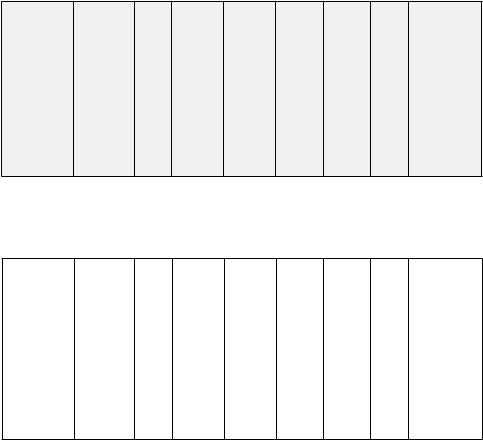
Enhancing Skills of Application Software via Web-Enabled Problem-Based Learning
Table 2. Independent samples t-test: Improvement of grades
|
|
N |
Mean |
S. D. |
F |
t-value |
df |
P |
|
|
|
|
|
|
|
|
|
Word |
PBL |
55 |
64.29 |
11.063 |
2.604 |
3.147 |
104 |
.002** |
|
|
|
|
|
|
|
|
|
|
non-PBL |
51 |
56.84 |
13.269 |
|
|
|
|
|
|
|
|
|
|
|
|
|
Excel |
PBL |
55 |
64.98 |
17.948 |
24.992 |
3.809 |
104 |
<.001** |
|
|
|
|
|
|
|
|
|
|
non-PBL |
51 |
46.43 |
30.943 |
|
|
|
|
|
|
|
|
|
|
|
|
|
PowerPoint |
PBL |
55 |
72.00 |
11.617 |
.029 |
2.186 |
104 |
.031** |
|
|
|
|
|
|
|
|
|
|
non-PBL |
51 |
66.98 |
12.016 |
|
|
|
|
|
|
|
|
|
|
|
|
|
Average |
PBL |
55 |
67.09 |
9.779 |
5.430 |
4.722 |
104 |
<.001** |
|
|
|
|
|
|
|
|
|
|
non-PBL |
51 |
56.75 |
12.673 |
|
|
|
|
**P < 0.05; *P < 0.1
Table 3. Independent samples t-test: The improvement of grades
|
|
N |
Mean |
S. D. |
F |
t-value |
df |
P |
|
|
|
|
|
|
|
|
|
Word |
SRL |
54 |
63.11 |
11.647 |
.102 |
2.018 |
104 |
.046** |
|
|
|
|
|
|
|
|
|
|
non-SRL |
52 |
58.21 |
13.325 |
|
|
|
|
|
|
|
|
|
|
|
|
|
Excel |
SRL |
54 |
62.37 |
23.770 |
2.483 |
2.554 |
104 |
.012** |
|
|
|
|
|
|
|
|
|
|
non-SRL |
52 |
49.50 |
28.021 |
|
|
|
|
|
|
|
|
|
|
|
|
|
PowerPoint |
SRL |
54 |
72.54 |
12.462 |
.222 |
2.649 |
104 |
.009** |
|
|
|
|
|
|
|
|
|
|
non-SRL |
52 |
66.52 |
10.831 |
|
|
|
|
|
|
|
|
|
|
|
|
|
Average |
SRL |
54 |
66.01 |
11.305 |
.769 |
3.473 |
104 |
.001** |
|
|
|
|
|
|
|
|
|
|
non-SRL |
52 |
58.08 |
12.195 |
|
|
|
|
**P < 0.05; *P < 0.1
and PowerPoint modules in PBL class (67.09) was onanaveragehigherthanthatinthenon-PBLclass (56.75). This is also true if one takes the test scores ofeach moduleintoaccountseparately. Therefore, effects of Web-based PBL on students’ skills of application software are positive, and higher than those who do not receive PBL.
Results from Table 3 show that the average grade for Word, Excel and PowerPoint modules in SRL group (66.01) is higher than that in the non-SRL group (58.08). This is also true if one takes test scores of each module into account separately. Thus, the effects of web-based SRL on students’ skills in using application software are positive, and higher than those without SRL intervention.
Finally, data from Table 4 shows that combination of PBL and SRL intervention a group results in the highest grades among four groups. The improvement of skills using application software in
C1issignificantlyhigherthanC3andC4,andalso higher than C2, though insignificant. Therefore, we conclude that the effects of Web-based PBL and SRL intervention on students’ skills in using application software are positive, and higher than those who do not receive PBL or/and SRL.
For those teachers who wish to stick to traditional methods of teaching, directly transforming their teaching material into electronic form may not be a fruitful approach. Students from the controlled group (C4) received lowest grades among fourgroups,anddifferencesingradesamongthem
201

Enhancing Skills of Application Software via Web-Enabled Problem-Based Learning
are significant (see Table 4). It is suggested that teachers should redesign their courses and then adoptnewinstructionalmethodsandtechnologies to fully exploit benefits of deploying Web-based learning environments.
DISCUSSION
This study provides valuable insights and sheds some lights on new, effective practices that can be used by schools (particularly vocational schools), scholars, and teachers planning to implement or presently engaged in implementing e-learning environments. The implications of this study consist of three-fold:
Firstly, the PBL teaching method was found to play a consistently positive role in enhancing students’ skills of using application software
(see Table 2). There are significant differences between PBL and non-PBL classes, either in case of individual module tests or in an average of the three module tests. It was demonstrated that PBL is good for computer software education in general and e-learning in particular. Teachers could
redesign their courses by simulating meaningful and interesting business situations, and, thus, engaging students’ imaginations and interest to solve challenging problems.
Secondly, evidence also supports that the second teaching method based on SRL also enhances students’ skills of using application software (see
Table3).Therearesignificantdifferencesbetween
SRL and non-SRL groups on three tests and in average. Interestingly, as we focused on the variation of P-value related to each module, it became clear that the effects of SRL increased over time. This suggests that the effects of SRL among low achieverscanbesignificantlyimproved,evenbya limited amount of intervention, such as two-hour lectureregardingSRLatthebeginningofteaching program and later by students’ monitoring their own learning.
Finally, this study found some support for the effectiveness of a combination of instructional methods. As shown in Table 4, results show that the effects of a combination of PBL and SRL intervention on students’ skills of application software are positive and higher than those who do not receive PBL or/and SRL, although the
Table 4. One-way ANOVA (Analysis of Variance): Average of the improvement of grades.
Dependent |
|
|
|
Mean Difference |
|
|
Variable |
|
(I) Group |
(J) Group |
(I-J) |
Std. Error |
Sig. |
|
|
|
|
|
|
|
Average |
Scheffe |
1 |
2 |
5.862 |
2.910 |
.262 |
|
|
|
|
|
|
|
|
|
|
3 |
8.436(*) |
2.943 |
.047 |
|
|
|
|
|
|
|
|
|
|
4 |
17.064(*) |
2.851 |
.000 |
|
|
|
|
|
|
|
|
|
2 |
1 |
-5.862 |
2.910 |
.262 |
|
|
|
|
|
|
|
|
|
|
3 |
2.574 |
3.071 |
.872 |
|
|
|
|
|
|
|
|
|
|
4 |
11.202(*) |
2.983 |
.004 |
|
|
|
|
|
|
|
|
|
3 |
1 |
-8.436(*) |
2.943 |
.047 |
|
|
|
|
|
|
|
|
|
|
2 |
-2.574 |
3.071 |
.872 |
|
|
|
|
|
|
|
|
|
|
4 |
8.628(*) |
3.015 |
.048 |
|
|
|
|
|
|
|
|
|
4 |
1 |
-17.064(*) |
2.851 |
.000 |
|
|
|
|
|
|
|
|
|
|
2 |
-11.202(*) |
2.983 |
.004 |
|
|
|
|
|
|
|
|
|
|
3 |
-8.628(*) |
3.015 |
.048 |
* The mean difference is significant at the .05 level.
202
Enhancing Skills of Application Software via Web-Enabled Problem-Based Learning
difference between C1 and C2 is not statistically significant.
This study contributes to e-learning practices inthreedifferentways:(a)thisstudyspecifieshow teachers can engage students in improving learning under authentic conditions. At the same time, teachers help students to regulate their learning by applying PBL and SRL instructional methods in a Web-based learning environment; (b) this study is one of the first attempts to explore learning effects of various combinations of PBL, SRL, and Web-based learning; and (c) this empirical study provides evidence that skills of low academic achievers, for using application software can be improved through e-learning.
Teachers face tremendous challenges in implementing e-learning among relatively low academic achievers. For example, Internet addiction is common, and it is not immediately clear how to focus students’ attention and improve their learning in a Web-based environment without teachers’ on-the-spot monitoring. This study proposes an effective approach in this kind of e-learning environment.
REFERENCES
Albanese,M.A.,&Mitchell,S.(1993).Problembased learning: A review of literature on its outcomes and implementation issues. Academic Medicine, 68(1), 52–81.
Azevedo,R.,&Cromley,J.G.(2004).Doestraining on self-regulated learning facilitate students’ learningwithhypermedia?JournalofEducational Psychology, 96(3), 523-535.
Barrows, H. (1985). How to design a problembased curriculum for the preclinical years. New York: Springer.
Barrows, H. (1986). A taxonomy of problembased learning methods. Medical Education, 20(6), 481-486.
Barrows, H., & Tamblyn, R. (1980). Problembased learning. New York: Springer.
Berkson,L.(1993).Problem-basedlearning:Have the expectations been met? Academic Medicine,
68(1), 79-88.
Bielaczyc K, Pirolli P., & Brown A. (1995).
Training in self-explanation and self-regulation strategies: investigating the effects of knowledge acquisition activities on problem solving. Cognition and Instruction, 13(2), 221–252.
Borkowski, J. G., & Thorpe, P. K. (1994). Self- regulationandmotivation:Alife-spanperspective on underachievement. In D. H. Schunk & B. J.
Zimmerman (Eds.), Self-regulation of learning and performance (pp. 45-73). Hillsdale, NJ: Lawrence Erlbaum Associates.
Boud, D. J. (1985). Problem-based learning in perspective. In D. J. Boud, (Ed.), Problem-based learning in education for the professions (pp. 13-18). Sydney: Higher Education Research and Development Society of Australasia.
Boud, D., & Feletti, G. (1991). The challenge of problem based learning. London: Kogan Page.
Bruer, J. T. (1993). Schools for thought: A science of learning in the classroom. Cambridge, MA: MIT Press.
Cennamo, K. S., Ross, J. D., & Rogers, C. S.
(2002). Evolution of a Web-enhanced course: Incorporating strategies for self-regulation. Educause Quarterly, 25(1), 28-33.
Chang, M. M. (2005). Applying self-regulated learningstrategiesinaWeb-basedinstruction-An investigation of motivation perception. Computer Assisted Language Learning, 18(3), 217-230.
Chanlin,L.J.,&Chan,K.C.(2004).Assessment of PBL design approach in a dietetic Web-based instruction. Journal of Educational Computing Research, 31(4), 437-452.
203
Enhancing Skills of Application Software via Web-Enabled Problem-Based Learning
Colliver J. A. (2000). Effectiveness of problembased learning curricula: Research and theory.
Academic Medicine, 75(3), 259-266.
Dabbagh, N., & Kitsantas, K. (2005). Using
Web-based pedagogical tools as scaffolds for self-regulated learning. Instructional Science, 33(5–6), 513–540.
Davies, P. (2000). Approaches to evidence-based teaching. Medical Teacher, 22(1), 14-21.
Davis, M. H., & Harden, R. M. (1999). Prob- lem-based learning: A practical guide. AMEE EducationGuide,15,http://www.amee.org/index. asp?tm=43
Dunlap, J. C. (2005). Changes in students’ use of lifelong learning skill during a problem-based learning project. Performance Improvement Quarterly, 18(1), 5-33.
Ertmer, P. A., Newby, T. J., & MacDougall, M.
(1996). Students’ approaches to learning from case-based instruction: The role of reflective self-regulation. American Educational Research Journal, 33(3), 719-752.
Greening,T.,Kay,J.,Kingston,J.H.,&Crawford, K.(1996).ResultsofaPBLtrialinfirst-yearcom- puter science. The 2nd Australasian Conference on Computer Science Education (pp. 201-206). New York: ACM Press.
Hmelo-Silver, C. E. (2004). Problem-based learning:Whatandhowdostudentslearn?Educational Psychology Review, 16(3), 235-266.
Kauffman, D. F. (2004). Self-regulated learning in Web-based environments: Instructional tools designed to facilitate cognitive strategy use, metacognitive processing, and motivational beliefs.
Journal of Educational Computing Research,
30(1 & 2), 139-161.
Lehman, S., Kauffman, D., White, M., Horn,
C., & Bruning, R. (2001). Teacher interaction:
Motivating at-risk students in Web-based high school courses. Journal of Research on Computing in Education, 33(5), http://www.iste. org/inhouse/publications/jrte/33/5/lehman-s. cfm?Section=JRTE_33_5
Lindner, R. W., & Harris, B. (1993). Teaching self-regulated learning strategies. In M.R. Simonson & K. Abu-Omar, (Eds.), Proceedings of selected research and development presentations at the annual conference of the Association for Educational Communications and Technology
(pp. 641–654). Ames, IA: Instructional Resources Center, Iowa State University.
Norman,G..,&Schmidt,H.(1992).Thepsycho- logicalbasisofproblem-basedlearning. Academic Medicine, 67(9), 557-565.
Nota, L., Soresi, S., & Zimmerman, B. J. (2004).
Self-regulation andacademicachievementand resilience: A longitudinal study. International Journal of Educational Research, 41(3), 198–251.
Paris, S. G.., & Paris, A. H. (2001). Classroom applications of research in self-regulated learning.
Educational Psychologist, 36(2), 89-101.
Perels, F., Gürtler, T., & Schmitz, B. (2005).
Training of self-regulatory and problem-solving competence. Learning and Instruction, 15(2), 123-139.
Polanco, R., Calderón, P., & Delgado, F. (2004).
Effects of a problem-based learning program on engineering students’ academic achievements in a Mexican university. Innovations in Education & Teaching International, 41(2), 145-155.
Poon,W.C.,Low,K.L.T.,&Yong,D.G.F.(2004).
A study of Web-based learning (WBL) environment in Malaysia. The International Journal of Educational Management, 18(6), 374–385.
204
Enhancing Skills of Application Software via Web-Enabled Problem-Based Learning
Reyero,M.,&Tourón,J.(2003).El desarrollo del talento:Laaceleracióncomoestrategiaeducativa [The development of talent: Acceleration as an educational strategy]. A Coruña: Netbiblo.
Risemberg, R., & Zimmerman B. J. (1992). Selfregulated learning in gifted students. Roeper Review, 15(2), 98-101.
Roces, C., & González Torres, M. C. (1998).
Capacidad de autorregulación del aprendizaje [Ability to self-regulate learning]. In J. A. GonzálezPienda&J.C.Núñez(Eds.),Dificultadesde aprendizaje escolar (pp. 239-259). Madrid: Pirámide/Psicología.
Segers, M., Dochy, F., & De Corte, E. (1999).
Assessment practices and students’ knowledge profilesinaproblem-basedcurriculum.Learning Environments Research, 2(2), 191–213.
Sonmez, D., & Lee, H. (2003). Problem-based learning in science, http://www.eric.ed.gov/ER-
ICWebPortal/recordDetail?accno=ED482724
Tai, C. F., Chen, R. J., & Lai, J. L. (2003). How technological and vocational education can prosperinthe21stcentury?IEEE Circuits & Devices Magazine, 19(2), 15-51.
Vernon, D., & Blake, R. (1993). Does problembased learning work? A meta-analysis of evaluative research. Academic Medicine, 68(7), 550563.
Walton, H., & Matthews, M. (1989). Essentials of problem-based learning. Medical Education, 23(6), 542-558.
Weinstein, C. (1989). Teacher education students’ preconceptions of teaching. Journal of Teacher Education, 40(2), 53-60.
Williams, S. M. (1993). Putting case-based learning into context: Examples from legal, business, and medical education. Journal of Learning Sciences, 2(4), 367-427.
Winnips, K. (2000). Scaffolding-by-design: A model for WWW-based learner support, Enschede: University of Twente Press.
Wu,T.Y.(2000).Integrativecurriculumplanningin technological and vocational education in Taiwan, Republic of China. http://www.eric.ed.gov/ER-
ICWebPortal/recordDetail?accno=ED450230
Yang, Y. (1993). The effects of self-regulatory skills and type of instructional control on learning from computer-based instruction. International Journal of Instructional Media, 20(3), 225-241.
Yip, W. (2001). Utilisation of the problem-based learning approach facilitated by information technology to teach information on systems development. http://citeseer.ist.psu.edu/535807.html
Young, J. D. (1996). The effect of self-regulated learning strategies on performance in learner controlled computer-based instruction. Educational Technology Research and Development,
44(2), 17-27.
Zimmerman, B. J. (1990). Self-regulated learning and academic achievement: An overview.
Educational Psychologist, 25(1), 3-17.
Zimmerman, B. J. (1998). Developing self-regula- tion cycles of academic regulation: An analysis of exemplary instructional model. In D. H. Schunk
&B.J.Zimmerman(Eds.),Self-regulated learn- ing:Fromteachingtoself-reflectivepractice(pp. 1-19). New York: Guilford.
Zimmerman, B. J., Bonner, S., & Kovach, R.
(1996). Developing self-regulated learners: Beyond achievement to self-efficacy. Washington, DC: American Psychological Association.
Zimmerman, B. J., & Martinez-Pons, M. (1986).
Development of a structured interview for assessing student use of self-regulated learning strategies. American Educational Research Journal,
23(4), 614-628.
205
Enhancing Skills of Application Software via Web-Enabled Problem-Based Learning
Zimmerman, B. J., & Schunk, D. H. (1989).
Self-regulated learning and academic achievement: Theory, research, and practice. New York: Springer-Veri
This work was previously published in International Journal of Distance Education Technologies, Vol. 6, Issue 3, edited by Q. Jin, pp. 69-84, copyright 2008 by IGI Publishing (an imprint of IGI Global).
206
207
Chapter 14
Constructivist Learning
Through Computer Gaming
Morris S. Y. Jong
Centre for the Advancement of Information Technology in Education, The Chinese University of Hong Kong, Hong Kong
Junjie Shang
Graduate School of Education, Peking University, Beijing, China
Fong-lok Lee
Centre for the Advancement of Information Technology in Education, The Chinese University of Hong Kong, Hong Kong
Jimmy H. M. Lee
Centre for the Advancement of Information Technology in Education, The Chinese University of Hong Kong, Hong Kong
ABSTRACT
Apart from the ability of computer games to make learning more interesting, a number of researchers and educators have been exploring other educational potentials of computer games. In parallel with the advancement of computer and information technology and the advocacy of constructivism in education, the issue of harnessing computer games to create new constructivist learning opportunities has received attention in both education and game research domains. This chapter is aimed at giving an introduction to computer game-based learning. Besides discussing computer games’intrinsic educational traits favouring constructivist learning from different perspectives, the authors also review a number of instances of two recent foci in the game-based learning domain. The first one is education in games that involves the adoption of existing recreational games in the commercial market for educational use. The second is games in education that entails designing and developing educational games articulated with different constructivist learning paradigms or pedagogical approaches.
DOI: 10.4018/978-1-60566-934-2.ch014
Copyright © 2010, IGI Global. Copying or distributing in print or electronic forms without written permission of IGI Global is prohibited.
Constructivist Learning Through Computer Gaming
INTRODUCTION
Computergameshavebecomeanimportantpartof the leisure lives of young generation (Kirriemuir
& McFarlane, 2004; Newman, 2004). This attention has been one of the common premises of various research on harnessing games1 in education for these decades (e.g., Adam, 1998; Betz,
1995; Bowman, 1982; Buckingham & Burn,
2007; Cameron, 2008; Egenfeldt-Nielsen, 2007;
Gredler, 2004; Jong, Shang, Lee & Lee, 2006, 2007;Lee,Lee&Lau,2006;Malone,1980,1981; Mason & Moutahir, 2006; Squire, 2003, 2005;
Shaffer, 2006).
Along with the advancement of multimedia, gaming, and Internet technology, as well as the pervasive promotion of student-centredness in education, the focus of game-based learning has been shifting from its original purpose of “sugaring” the process of learning onto today’s purpose of offering students constructivist learning experiences. A number of contemporary game-based learning researchers have been endeavouring to investigatehowtoemploytheintrinsiceducational traits of games for exploiting new constructivist learning environments. In general, their work can becategorizedintotwomainresearchfoci,namely,
(1)educationingames,and(2)gamesineducation. The former adopts existing recreational games in the commercial market for educational use, while the latter designs and develops educational games articulated with different constructivist learning paradigms or pedagogical approaches.
In this chapter, firstly, we discuss what and how the intrinsic traits of games can promote constructivist learning. After that, we review a number of instances of the recent research foci in the game-based learning domain. Further, we give an introduction to our recent game-in-education work, before our concluding remarks are given.
INTRINSIC EDUCATIONAL
TRAITS OF GAmES
The discussion of utilizing games for learning and teaching has started since the widespread popularity of Pac-Man in the early 1980s (Squire, 2003). Without doubt, the “games” discussed in most of today’s game-based learning research are quite different from the ones that were used in education in the last few decades. The differences are not only in games’ technical enhancement (e.g., more sophisticated 3D user interfaces, dynamic synchronous players’ interaction, etc.) brought by the advancement of technology, but also their underpinning learning philosophy, shifting from behaviourism (Rachlin, 1991; Skinner, 1938) to constructivism (Bruner, 1960; Papert, 1993; Piaget, 1964, 1970). In direct contrast to behaviourist education, constructivist education emphasizes that students should construct knowledge on their own. Students’ learning is not imposed simply by conditioning and reinforcement, but rather a cognitive and socio-cultural interaction in an engaging and authentic learning environment
(Otting & Zwaal, 2007).
Initiating and sustaining students’ learning motives through gaming has been one of the significant research areas of game-based learning (e.g., Bowman, 1982; Cordova & Lepper,
1996; Malone, 1980, 1981; Martens, Gulikers
& Bastiaens, 2004). More recently, researchers in the domain (e.g., Aylett, 2005; Gee, 2003,
2005; Kirriemuir & McFarlane, 2004; Mason &
Moutahir, 2006; Prensky, 2001, 2006; Shaffer, 2006; Squire, 2005) have also argued that the underlying cognitive and socio-cultural features of games can offer various “educative” opportunities to students. In the following, we will discuss games’ intrinsic educational traits that promote constructivist learning from the motivational, cognitive and socio-cultural perspectives.
208
Constructivist Learning Through Computer Gaming
motivational Perspective
Constructivist learning theorists (e.g., Papert, 1993; Piaget, 1964, 1970) realize that game-like activities can foster students’ deep learning. It is because, in those activities, students are willing to spend more time and effort on learning. They also feel better about what they learn, and will try to apply the acquired knowledge and skills in the future.
There have been a number of game-based learning studies focusing on investigating what, why, and how gaming can make students more motivated during the process of learning. Based on a series of surveys, observations and interviews with gamers, Malone (1980, 1981) put forward a motivation theory, which asserts that challenge, fantasy, control, curiosity, cooperation, recognition, and competition are the most significant elements that make gaming fun and engaging, and sustain gamers’ continual motives. Malone advocated that schools should try to integrate gaming elements into curricula so as to arouse students’intrinsic motives in learning.Apart from that, Bowman (1982) tied his study on learning through gaming with Csikszentmihalyi’s (1975, 1990) psychological conception of flow. Flow is a state of experience of “intense concentration and enjoyment.” Under the flow state, a person will engage in a complex, goal-directed challenge not for external rewards, but simply for the exhilaration of dealing with the challenge. Bowman believed that learning through gaming is a spontaneous way to bring students to the flow state of learning. Although Bowman’s work was done more than two decades ago, recent empirical evidence (e.g., DeLisi & Wolford, 2002) still accords with his assertion.
Fun and enjoyment are essential elements in the process of learning as students can be more relaxed and motivated to learn (Bisson & Luncker,1996;Cordova&Lepper,1996).Gamers always undergo hard but engaging, challenging but pleasurable, and risk-taking but rewarding
experiences in gaming (Prensky, 2001). All these are the experiences of fun and enjoyment. From both theoretical and empirical points of view, it is expected that students are more motivated to participate in educational activities if these activities take place in a form of gaming.
Cognitive Perspective
The traditional school curricula are often fragmentedintosmallandunconnectedpieces(Papert, 1993). The original intention is for making learning easier, but this usually ends up neglecting the rationale behind the knowledge itself, creating unrealistic learning contexts, and rendering the whole learning process boring. Without chunking or turning learning content into a series of split-screens, a well-designed game does well in presenting near real-life context for students to acquire knowledge and skills unintentionally rather than deliberately (Gee 2003).This sort of learning experience coincides with Lave and Wenger’s (1991) conception of situated learning.
When discussing games’educational potential from the cognitive perspective, we should first classify today’s games into mini-games or com- plex-games (Prensky, 2006). In general, playing mini-games takes around several minutes to an hour. Usually, these games contain simple challenges and content, with neither ethical dilemma nor humangamers’interaction.Incontrastto minigames, complex-games require gamers’ dozens of hours (or even more) of concentrated attention to master. Most tasks therein are generative and open-ended without prescribed gaming strategies. Gamers engaged in complex gaming cannot be passive(Antonacci&Modaress,2008).Theyhave to analyze the perceived information and context in the games proactively, and then apply their existing knowledge and skills to formulate strategies, make decisions, and then examine results. It is also necessary for them to acquire new and multiple skills, and interact (compete, cooperate or collaborate) with other human gamers or NPCs
209
Constructivist Learning Through Computer Gaming
(non-player characters) inside the games (Gee,
2003; Mason & Moutahir, 2006).
Complex games offer the prospect of userdefined learning environments (Halverson, 2005) in which individuals can try out and get feedback on their assumptions and strategies. This is a new cognitive way for learners to acquire knowledge and skills in a constructivist fashion (Shaffer,
Squire, Halverson & Gee, 2005).
Socio-Cultural Perspective
How to educate students is not seen as how to build representations in each of their heads, but how to engage them in social practices (Lave
& Wenger, 1991). Knowledge itself arises from social needs, fulfills social functions, and is tied inherently with cultural conditions (Cole, 1996). Thus, learning is not just a process of mastering facts, or even doing complex tasks, but rather, participating in socio-cultural practices. This requires learners to develop their own identity in relation to others.
Most of today’s gaming activities are situated socially and culturally (Gee, 2003), entwining practice, participation, community, and identity (Wenger, 1998).The gamer generation prefers human competitors and/or collaborators rather than purely artificial intelligence (AI) (Prensky, 2001). Gamers meet online and form teams to discuss challenges, complete quests, and solve puzzles. Moreover, nearly every prevalent game does not simply appear alone as a game itself, but exists logicallyasagamesystem(Prensky,2006).Ineach of these systems, besides a complex game concatenating with a built-in real-time chat console, it also entails gamers’ self-initiated components, suchasonlinediscussionforums,fans’sites,blogs, etc. All these components enable and encourage individuals to share, discuss, evaluate and apply the community knowledge co-constructed by the community members.
In didactic schooling approaches, learning takes place through teaching and testing (Gee,
2005), and students can merely gain standardized learning experiences (Halverson, 2005). Compared to those traditional approaches, game-based learning can create a more social and cultural world that helps individuals learn by integrating thinking and social interactions (Shaffer et al., 2005). Moreover, the whole learning process does not necessarily need to be face-to-face and take place at school.
CONTEmPORARY GAmE-BASED
LEARNING STRATEGIES
When the idea of “learning through gaming” was first introduced into education, most of the socalled “educational games” were designed mainly based on the drill-and-practice learning principle (Egenfeldt-Nielsen, 2007). Usually, those games had a clear reward structure that was used as a way topushstudents’learningforwards.Itwasassumed that students could be put in front of computers, and then learned the designated content and skills through drills and practice, without teachers’help or involvement. For example, in Math Blaster!2, students have to shoot down the right answer to the mathematics question shown on the screen. On each success, the player’s balloon will move towards a needle. A student who can pop his/her balloon eventually will win the game.
Squire (2003) observed that drill-and practice games are still popular in today’s education. It is because they can be integrated easily into ordinary school curricula as enrichment exercises for students to reinforce their exiting knowledge or skills during their independent study time. However, a number of educators and researchers
(e.g., Card, 1995; Gredler, 2004; Kirriemuir &
McFarlane, 2004; Papert, 1993; Prensky, 2001) have been criticizing that drill-and-practice games lack integration of learning experience into gaming experience, and promote rote memorization. “Parrot-like” learning will result in weak transfer
210
Constructivist Learning Through Computer Gaming
and application of knowledge and skills (Gee,
2003; Jonassen & Howland, 2003).
Contemporary game-based learning researchers (e.g., Adam, 1998; Aylett, 2005; Cameron, 2008; Gee, 2003, 2005; Ip, Luk, Cheung, Lee
& Lee, 2007; Johnson, 2005; Jong et al., 2006,
2007; Lee et al., 2006; Shaffer, 2006; Squire 2005) believe learning through gaming can be much more than drilling and practicing. The ability of today’s games to sustain spontaneous gamers’ engagement, offer gamers near real-life experiences, and exploit proactive gamers’communities makes gaming another possible means to realize constructivist education. In the following, we will review and discuss a number of constructivist game-based learning instances in the domain. In general, they can be categorized into two research foci, namely, education in games, and games in education.
Education in Games
Gee (2003) has been advocating the exploration of the possibility of adopting recreational games in the commercial market for educational use. He argued that many bestselling recreational games (e.g., Full Spectrum Warrior3) are already state- of-the-art learning games as they are hard but fun, time-consuming but enjoyable, and complex but “learnable.”As an education-in-game proponent, Adam (1998) adopted a prevalent recreational game,SimCtiy20004, into auniversity-levelintro- ductory urban geography class for the students to acquire urban planning concepts through playing the game in a self-directed manner. SimCity 2000 is a “city-building” simulation game. The game cannot only approximate near real-world conditions and phenomena of designing and building a city, but can also demonstrate the potentially successful or disastrous consequences of complex decision making in urban planning. Prior to the adoption, Adam analyzed SimCity 2000, and set up a number of learning objectives related to urban planning that they expected students
could achieve after playing the game. Further, he conducted a number of learning experiments to verify quantitatively whether those gaming experiences would yield the expected students’ learning outcomes. The research results revealed that, in terms of students’ knowledge acquisition (urban planning concepts) and their perceptions of “learning through gaming,” the game-based learning adoption in Adam’s study yielded positive outcomes.
Another education-in-game proponent, Squire (2005), investigated the possibility of integrating another prevalent recreational game, Civilization III5, into a US high-school classroom for teaching the formal world-history curriculum. Civilization III allows players to lead a civilization from 4000 BC to the present, with a mission to compete for political, scientific, military, cultural, and economic victories. In this game, each player has to seek geographical resources, manage economics, plan the growth of his/her own civilization, and engage in diplomacy with other players competitively and collaboratively. In the study, although Squire concluded that the students could develop more understanding and interest in historical knowledge, he remarked that it was difficult to align the “educative” content in the game with what was required in the subject curriculum. In fact, this remark, to a certain extent, coincided with some other similar arguments made by other game-based learning researchers. Mishra and Foster (2007) realized that it is hard to integrate existing recreational games into existing school curricula, as those games are designed originally for entertainment purpose, rather than education purpose. It is difficult for teachers to identify what and how a particular part of a recreational game is relevanttoaparticularpartofasubjectcurriculum. On top of that, the authenticity and accuracy of the “educative” content of recreational games are another cause for concern over the integration of recreational games into formal schooling (Kirriemuir & McFarlane, 2004).
211
Constructivist Learning Through Computer Gaming
More recently, there has been literature (e.g., Gee, 2005; Prensky, 2006; Reese, 2007; Salen, 2007), from a more theoretical perspective, discussingrecreationalgames’potentialforpreparing youngsters to become the skilled workforce in the twenty-first century. Nevertheless, some critics
(e.g., Egenfeldt-Nielsen, 2007; Mishra & Foster,
2007) have been arguing that those claims lack empirical evidence, and most ideas therein still remain philosophical arguments.
Games in Education
Instead of adopting existing recreational games in the commercial market, a number of gamebased learning researchers design and develop educational games articulated with different constructivist learning paradigms. For example, distributed authentic professionalism (Gee, 2005) is the underlying learning paradigm of Shaffer’s (2006) educational games. Distributed authentic professionalism refers to the distribution of authentic professional expertise between NPCs (non-player characters) and gamers’ avatars while gamers are engaged in specific activities during gaming. Professional knowledge and practice are embodied through the interactions between NPCs and gamers. Thus, gamers can gain first-hand experiences on how members of these professions think, behave, and solve problems. The whole cognitive process is situated both socially and culturally. Shaffer (2006) gave a more detailed account of Gee’s (2005) idea of distributed authentic professionalism. He realized that members of a profession have an epistemic frame—a particular way of thinking and working, i.e., a grammar of a particular culture. In other words, epistemic frames are the conventions of participation that learners become internalized and acculturated. Thus, developing students to be members of a particular profession is a matter of equipping them with a right epistemic frame. To accomplish this, Shaffer and his colleagues developed a number of epistemic games which
allow students to participate in simulations of various professional communities that they might someday inhabit. The communities include, for example,biomechanicalengineersinDigitalZoo6, ecological thinkers in Urban Science7 journalists in Journalism.Net8, etc.
Lee et al. (2006) proposed a constructivist learning paradigm for designing educational games, namely, Folklore-based learning. This paradigm suggests that learning takes place in an interactive adventure highlighted by problemsolving tasks which are situated in a folklorebased story plot. It is not only aimed at enabling students to learn in an authentic environment, but also offering interesting story episodes as a motivating agent for less initiated students. As prototype work, Lee et al. developed a game to realize this learning paradigm, namely, Tong Pak Fu and Chou Heung9, based on the topic of probability in Mathematics education. This game is composed of several gaming stages, from sample space construction in the first stage, to simple probability, to conditional probability, and eventually to the Monty Hall Problem (Fowler, 1996) in the last stage. In each stage, students are presented a problematic scenario and required to solve the problems therein in order to proceed to the next stage.
Emergent narrative is the underlying constructivist learning paradigm of Aylett’s (2005) narrative games. This paradigm suggests learning through role-playing in an improvised, rather than scripted digital story. The plot of the story in a narrative game emerges from the interactions between players’ avatars and NPCs therein. If necessary, a teacher can participate in the game to intervene the emerging story so as to facilitate his/her students’ learning. FearNot! (Aylett,
Figuieredo, Louchart, Dias & Paiva, 2006) is an instance of narrative games. It was designed to educate children against bullying behaviour at school. Students in this game act as counselors to give advice to victims (the NPCs in the game) who are being bullied at school. Their advice will
212
Constructivist Learning Through Computer Gaming
influence the proceedings about the victims in the next episode. Thus, students can observe the consequence of the actions taken by the victims in accordance with their prior advice. This game offers a safe environment for students to witness bullying incidences and reflect on how they have to cope with these incidences in real life.
4. OUR GAmE-IN-EDUCATION WORK
In this section, we will introduce two pieces of our recent game-in-education work. The first one is Learning Villages10 (Ip et al., 2007; Jong, Tse, Zhou, Chen, Lee and Lee, 2008)—a massively multi-player online game to support collaborative learning. The second is Virtual Interactive Student-Oriented Learning Environment (Jong et al., 2006, 2007)—a constructivist pedagogical approach to game-based learning.
Learning Villages
CSCL (Computer-Supported Collaborate Learning) refers to the process of a group of students engaging in discussing their perspectives on a problem with the goal of knowledge acquisition through a computer-based communicative platform (Weinberger & Fischer, 2005). Success of a group is attributed to all group members rather than merely the group leader (Scardamalia &
Bereiter, 2003). Each member is responsible for knowing what needs to be known, and ensuring others to know the same.
Learning Villages (LV) is a game-based CSCL platformthatoperatesinaformofmassivelymultiplayer online gaming, in which each student can design his/her own virtual character (an avatar) to participate in this virtual world. There are various entertainingelementsin LV.Forexample, students can earn the passion value and upgrade their own symbolic status through playing a range of minigames. Furthermore, there are various “hangout places” for students to meet one another. The
interactions include real-time chat, making funny gestures and showing funny emotional icons to draw others’attention, etc. Figure 1 shows one of the hangout places in LV. Besides the entertainment, LV facilitates students’ 2-tier issue-based discussionforcollaborativelearning.Thefirst-tier is “village-level discussion,” while the second-tier is “house-level discussion.”
Bothlevelsofdiscussioncantakeplaceconcurrently. Each village in LV represents a discussion issue.Astudent can create a village, taking the role of Chieftain by initiating an issue for discussion. Any other students in LVwho are interested in that issue, can become Villagers by building houses in that village. They can use houses to elaborate, for example, their perspectives, arguments or some related concepts with respect to the issue. In addition,studentscanbuildroadsbetweenthehousesto interconnect different perspectives, arguments or concepts delineated in the village. They can make use of different types of roads, namely, Explanation, Evidence, Problem, My Reply, Solve This First, Another View, Compare With, and Others to reflect the different relationships between the elaborations represented by those houses. This is called village-level (the first-tier) discussion. An example is shown in Figure 2.
In the village, every house is “enterable,” and it functions as an individual forum to facilitate discussion on a specific perspective, argument or concept raised in the village-level discussion. In LV, the term “postings” is used to represent the discussion threads inside houses (see Figure 3). This is called house-level (the second-tier) discussion. The more postings there are in a house, the larger its size and the higher its modernity level will be. The advantage of the 2-tier design in LV is that, major perspectives, arguments and related concepts,aswellastheirrelationshipswithrespect to a discussion issue can be arranged neatly in the form of mind mapping at the village level. However, it is still handy for students to review the details of a particular perspective, argument, or concept discussed at the house level.
213
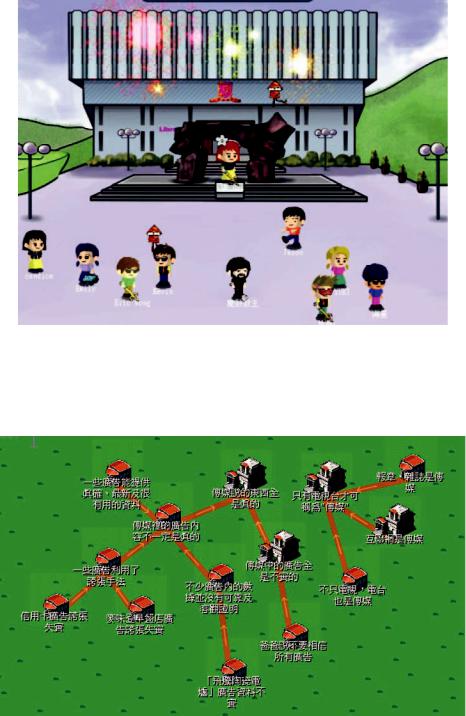
Constructivist Learning Through Computer Gaming
Figure 1. A hangout place in LV
Figure 2. Village-level discussion
214
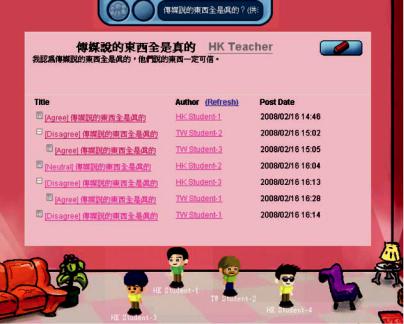
Constructivist Learning Through Computer Gaming
Figure 3. House-level discussion
In order to encourage students to participate in quality issue-based discussions, the invest- and-reward mechanism is one of the strategies adopted in LV for the purpose. Every time when a student creates a village, or builds a house in villages created by others, he or she has to pay “donuts” (the virtual money in LV). Nevertheless, when the number of quality houses and postings in the villages (that he or she has “invested” in) reaches a certain amount, the village will be upgraded by either the LV system administrator or their learning facilitators (usually their teachers). Benefits brought about by the upgrade include donut reward, higher social status conferment for enjoying extra privileges in LV, etc.
Virtual Interactive Student-
Oriented Learning Environment
Virtual Interactive Student-Oriented Learning Environment (VISOLE) is a constructivist pedagogical approach to empower game-based learning. This approach encompasses the creation of a near
real-life online interactive world modeled upon a set of multi-disciplinary domains, in which each student plays a role in this “virtual world” and shapes its development. In VISOLE, we adopt a game-pedagogy co-design strategy in which we emphasize the importance of teachers and their roles therein. Upon the theoretical foundation11 of intrinsic motivation (Malone, 1980, 1981), situated learning (Lave&Wenger,1991),scaffolding
(Vygotsky, 1978), and debriefing (Thiagarajan, 1998), VISOLE is framed into three operable pedagogical phases, namely Multi-disciplinary Scaffolding (Phase 1), Game-based Situated Learning(Phase 2),and ReflectionandDebriefing
(Phase 3), as diagrammatically shown in Figure 4. Please note that Phase 2 and Phase 3 take place in an interlacing fashion, but Phase 2 starts a bit earlier than Phase 3.
•Phase 1: Multi-disciplinary scaffolding.
VISOLE teachers act as cognitive coaches to activate VISOLE students’ learning motive, and assist them in gaining some preliminary
215
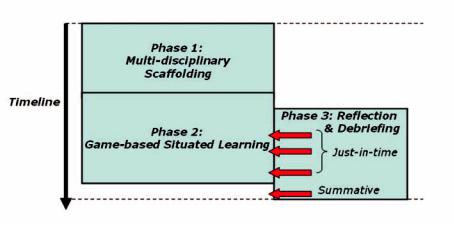
Constructivist Learning Through Computer Gaming
Figure 4. Three pedagogical phases of VISOLE
|
high-level abstract knowledge (prior knowl- |
|
decisions on others contextually and socio- |
|
edge) based upon a selected multi-disciplin- |
|
culturally. “Being situated” in this virtual |
|
ary framework. In this phase, students are |
|
world, not only do students have to acquire |
|
equipped with “just enough” knowledge, |
|
the subject-specific knowledge in a multi- |
|
and given only some initial “knowledge |
|
disciplinary fashion, but they also need the |
|
pointers.” They have to acquire the neces- |
|
generic skills of problem analysis, strategy |
|
sitated knowledge and skills on their own |
|
composition, decision making, etc. |
|
in the next learning phase, not only from |
• |
Phase 3: Reflection and debriefing. This |
|
the designated learning resources but also a |
|
phase interlaces with the activities in Phase |
|
wider repertoire of non-designated learning |
|
2. After each gaming session, students are |
|
resources, such as the Internet. |
|
required to write their own reflective jour- |
• |
Phase 2: Game-based situated learning. |
|
nal to internalize their learning experience |
|
This phase deploys an online multi-player |
|
in the virtual world in a just-in-time fash- |
|
interactive game portraying a virtual world. |
|
ion. Moreover, at the end of this phase, |
|
The scenarios therein become the domi- |
|
they are required to write their own report |
|
nant motivator driving students to go on to |
|
in a summative fashion to reflect on their |
|
pursue the inter-related understandings of |
|
overall learning experience. In addition, |
|
the multi-disciplinary abstractions encoun- |
|
teachers monitor closely the progress of |
|
tered in Phase 1. The game encompasses |
|
students’ development of the virtual world |
|
the creation of a virtual interactive world |
|
at the backend, and look for and try to act |
|
in which each student plays a role to shape |
|
on “debriefable” moments to “lift” students |
|
the development of this world for a period |
|
out of particular situations in the game. |
|
of time. The missions, tasks and problems |
|
Respectively during the course and at the |
|
therein are generative, and there is no pre- |
|
end of this phase, teachers extract prob- |
|
scribed solution. Since every single action |
|
lematic and critical scenarios arising in |
|
can affect the whole virtual world, stu- |
|
the virtual world, and then conduct just-in- |
|
dents have to take account of the overall |
|
time and summative case studies with their |
|
effects associated with their strategies and |
|
students in face-to-face debriefing classes. |
216
Constructivist Learning Through Computer Gaming
FARMTASIA (Cheung, Jong, Lee, Lee, Luk,
Shang & Wong, 2008) is the first online game following the pedagogical paradigm of VISOLE. It involves the subject areas of geography (natural environmentandhazards,aswellasenvironmental problems),biology,economics(includinggovernment, and production system) and technology. The “virtual world” of FARMTASIA consists of interactingfarmingsystems,coveringthedomains of cultivation, horticulture, and pasturage. In the game, every student acts as a farm manager to run a farm which is composed of a cropland, an orchard, and a rangeland. Each student competes for financial gain and reputation with three other farm managers who are also at the same time running their own farm somewhere nearby in the samevirtualworld.Throughoutthegamingperiod, students have to formulate various investment and operational strategies to yield both quality and abundant farm products to the market for making profit. Nevertheless, the richest may not be the final winner. Students’ final reputation in the virtual world is another crucial judging criterion, which is determined by their practices on sustainable development and environmental protection. “Wise Genie,” who is one of the game characters, will appear in the virtual world for giving advice or hints to students in some critical moments.
In order to enable teachers to review students’ performance in the game, a “record-and-replay” system is implemented in FARMTASIA. While students run their own farm in the virtual world, the system logs their every single gaming action. Teachers can make use of the teacher console to re-transform the logging stored in the game server intostudents’gamingproceedings,andthenreplay the proceedings in a form of “video” playback. With the record-and-replay system, teachers can look for and extract interesting, problematic, or critical scenarios taking place in the virtual world to conduct just-in-time and summative case studies with their students. Since all these scenarios come from students’ actual gaming experiences, it is easier for them to recognize, empathize, and
understand the constructive and destructive occurrences therein, and the corresponding enhancement and corrective actions.
5. CONCLUSION
In this chapter, we have introduced briefly the background of game-based learning, from the early 1980s’drill-and-practice learning paradigm to the recent constructivist learning paradigm, and from its original purpose of “sugaring the pills” to today’s purpose of sustaining learners’intrinsic engagement and exploiting cognitive and sociocultural learning environments. Besides elaborating on a number of intrinsic educational traits of today’s games that favor constructivist learning, we have also reviewed two recent research foci in the game-based learning domain, namely, education in games, and games in education.
Education-in-game researchers (e.g., Adam, 1998; Gee, 2003; Squire, 2005) have focused on investigating the possibility of a direct transformation of entertainment into edutainment. Nevertheless, some game-based learning commentators (e.g., Rice, 2007) realize that the education-in-game approach is more suitable to support students’ after school informal learning, rather than formal schooling. On the other hand, instead of adopting existing recreational games in the commercial market, game-in-education researchers (e.g., Aylett, 2005; Ip et al., 2007; Jong et al., 2006, 2007; Lee et al., 2006; Shaffer, 2006) have focused on designing and developing educational games articulated with different constructivist learning paradigms or pedagogical approaches.
We have no intention to argue that all learning should be via gaming. However, we believe that game-based learning could be an integral part of our education systems allowing a variety of contemporary pedagogical approaches to coexist and interplay. Some researchers argued that today’seducationalenvironmentisstillnotflexible
217
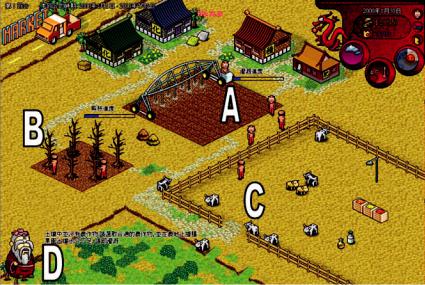
Constructivist Learning Through Computer Gaming
Figure 5. The gaming interface of FARMTASIA (A) Cropland, (B) Orchard, (C) Rangeland, & (D) Wise Genie
enough to accommodate game-based learning in place (e.g., Squire, 2005), and the real integration of games into formal schooling has not yet been explored systematically (e.g., Halverson, 2005). Apart from discussing how to design and develop the best games for the educational use, the actual adoption, implementation, and evaluation of game-based learning within school and institution settings are issues which need to be addressed.
We hope our discussion in this chapter can generate a flash of inspiration for game-based learning researchers, educators, school teachers, game designers, as well as game companies, when reflecting on the questions of what, why, how, and whengamingcanbeeducational.Morematureand comprehensive frameworks for the educational use of games (either the education-in-games approach or games-in-education approach) will emerge soon, provided that we continue to pursue open discussion and conversation within multiple fields and disciplines.
REFERENCES
Adams, P. C. (1998). Teaching and learning with SimCity 2000. The Journal of Geography, 97, 47–55. doi:10.1080/00221349808978827
Antonacci,D.,&Modaress,N.(2008).Envision- ingeducationalpossibilitiesofuser-createdvirtual worlds. AACE Journal, 16(2), 115–126.
Aylett, R. (2005). And they both lived happily ever after? Digital stories and learning. In G. Dettori, T. Giannetti, A. Paiva, & A. Vaz (Eds.),
Technology-mediated narrative environments for learning.Amsterdam:SensePublishers.Retrieved January 15, 2009, from http://www.macs.hw.ac. uk/~ruth/Papers/narrative/Kal-Lisbon.pdf
Aylett, R., Figuieredo, R., Louchart, S., Dias, J.,
&Paiva,A.(2006).Makingitupasyougoalong
- improvising stories for pedagogical purposes.
In J. Gratch, M.Young, R.Aylett, D. Ballin, & P.
Olivier (Eds.),Proceedings of the 6th International Conference IVA 2006 (pp. 307-315).
218
Constructivist Learning Through Computer Gaming
Betz, J. A. (1995). Computer games: Increase learning in an interactive multidisciplinary environment. Journal of Educational Technology Systems, 24(2), 195–205. doi:10.2190/119M- BRMU-J8HC-XM6F
Bisson, C., & Lunckner, J. (1996). Fun in learning: The pedagogical role of fun in adventure education. Journal of Experimental Education,
9(2), 109–110.
Bowman, R. F. (1982).APac-Man theory of motivation.Tacticalimplicationsforclassroominstruction. Educational Technology, 22(9), 14–17.
Bruner, J. S. (1960). The process of education. Cambridge: Harvard University Press.
Buckingham,D.,&Burn,A.(2007).Gameliteracy in theory and practice. Journal of Educational Multimedia and Hypermedia, 16(3), 323–349.
Cameron, B. (2008). Gaming, cognitive style, and feedback in the achievement of learning objectives.InT.T.Kidd,&H.Song(Eds),Handbook of research on instructional systems and technology
(pp. 416-448). Hershey, PA: Information Science Reference.
Card, O. S. (1995). What are computers doing at school. Windows Sources.
Cheung, K. K. F., Jong, M. S. Y., Lee, F. L., Lee,
J.H. M., Luk, E. T. H., Shang, J. J., & Wong, M.
K.H. (2008). FARMTASIA: An online gamebased learning environment based on theVISOLE pedagogy. Virtual Reality (Waltham Cross), 12(1), 17–25. doi:10.1007/s10055-008-0084-z
Cole, M. (1996). Cultural psychology:Aonce and future discipline. Cambridge, MA: The Harvard University Press.
Cordova,D.I.,&Lepper,M.R.(1996).Intrinsic motivation and the process of learning: Beneficial effects of contextualization, personalization, and choice. Journal of Educational Psychology, 88, 715–730. doi:10.1037/0022-0663.88.4.715
Csikszentmihalyi, M. (1975). Beyond boredom and anxiety. San Francisco: Jossey-Bass.
Csikszentmihalyi, M. (1990). Flow: The psychology of optimal experience. New York: Harper &
Row.
DeLisi, R., & Wolford, J. L. (2002). Improving children’s mentalrotationaccuracywithcomputer gameplaying.TheJournalofGeneticPsychology,
163(3), 272–282.
Egenfeldt-Nielsen, S. (2007). Third generation educational use of computer games. Journal of Educational Multimedia and Hypermedia, 16(3), 263–281.
Fowler, G. (1996). Monty Hall (let’s make a deal) Problem. Retrieved January 15, 2009, from http:// www.nadn.navy.mil/MathDept/courses/pre97/ sm230/MONTYHAL.HTM
Gee, J. P. (2005). What would be a state of the art instructional video game look like? Retrieved January 15, 2009, from http://www.innovateonline.info/index.php?view=article&id=80
Gee. J. P. (2003). What video games have to teach us about learning and literacy. New York: Palgrave Macmillan.
Gredler, M. (2004). Game and simulations and theirrelationshipstolearning.InD.Jonassen(Ed.),
Handbook of Research on Educational Communications and Technology (2nd ed., pp. 571-581). New Jersey: Lawrence Erlbaum Associates.
Halverson, R. (2005). What can K-12 school leaders learn from video games and gaming? Innovate, 1(6). Retrieved January 15, 2009, from http://www.innovateonline.info/index. php?view=article&id=81
219
Constructivist Learning Through Computer Gaming
Ip, C. W. H., Luk, E. T. H., Cheung, K. K. F.,
Lee, J. H. M., & Lee, F. L. (2007).Agame-based computer supported collaborative learning environment: Learning Villages (LV). In Proceedings of the 11th Annual Global Chinese Conference on Computers in Education (pp. 289-292). 26-30 May, Guangzhou, China.
Johnson, S. (2005). Everything bad is good fro you. New York: Penguin.
Jonassen,D.H.,&Howland,J.(2003).Learning to solve problems with technology: A constructivist perspective. Upper Saddle River, N.J.: Merrill Prentice Hall.
Jong,M.S.Y.,Shang,J.J.,Lee,F.L.,&Lee,J.H.
M. (2006).Anew vision for empowering learning and teaching with IT: The VISOLE approach. In
Proceedings of the Hong Kong International IT in Education Conference 2006: CapacityBuilding for Learning through IT (pp. 18-25). 6-8 February, HKSAR, China.
Jong,M.S.Y.,Shang,J.J.,Lee,F.L.,&Lee,J.H.
M. (2007). An exploratory study on VISOLE—A new game-based constructivist online learning paradigm. Paper presented at American Educational Research Association Annual Convention 2007 (AERA 2007). Chicago, IL.
Jong, M. S. Y., Tse, A. W. C., Zhou, Y. Z., Chen,
W. Q., Lee, F. L., & Lee, J. H. M. (2008). Using posting templates for enhancing students’ argumentative elaborations in Learning Villages. In Proceedings of the 2nd IEEE International Conference on Digital Game and Intelligent Toy Enhanced Learning (DIGITEL 2008) (pp. 180187). Banff, Canada. Los Alamitos, CA: IEEE Computer Society.
Kirriemuir,J.,&McFarlane,A.(2004).Literature review in games and learning (No. 8). Bristol, UK: Futurelab.
Lave,J.,&Wenger,E.(1991).Situated learning: Legitimate peripheral participation. Cambridge, UK: Cambridge University Press.
Lee, J. H. M., Lee, F. L., & Lau, T. S. (2006).
Folklore-based learning on the web—peda- gogy, case study, and evaluation. Journal of Educational Computing Research, 34(1), 1–27. doi:10.2190/3HFM-D9NQ-G7Y7-QC1G
Malone, T. W. (1980). What makes things fun to learn?Astudyofintrinsicallymotivatingcomputer games. Palo Alto: Xerox.
Malone, T. W. (1981). Toward a theory of intrinsically motivating instruction. Cognitive Science, 4, 333–369.
Martens, R. L., Gulikers, J., & Bastiaens, T.
(2004). The impact of intrinsic motivation on e-learning in authentic computer tasks. Journal of Computer Assisted Learning, 20, 368–376. doi:10.1111/j.1365-2729.2004.00096.x
Mason, H., & Moutahir, M. (2006). Multidisciplinary experiential education in Second Life: A global approach. In J. Kemp, & D., Livingstone
(Eds.), In Proceedings of the Second Life Education Workshop at the Second Life Community Convention (pp. 30-34), San Francisco.
Mishra, P., & Foster,A. N. (2007).The claims of games: A comprehensive review and directions for future research. In [SanAntonio, Texas.]. Proceedings of Society for Information Technology and Teacher Education Interactional Conference,
2007, 2227–2232.
Newman, J. (2004). Videogames. London: Routledge.
220
Constructivist Learning Through Computer Gaming
Otting,H.,&Zwaal,W.(2007).Theidentification of constructivist pedagogy in different learning environments. In M. K. McCuddy, H. van-den-
Bosch,W.B.,Martz,A.V.Alexei,&K.O.Morseb
(Eds.), The challenges of educating people to lead inachallengingworld(pp.171-196).Netherlands: Springer.
Papert, S. (1993). The children’s machine: Rethinking school in the age of the computers. New York: Basis Books.
Piaget,J.(1964).Developmentandlearning. Journal of Research in Science Teaching, 2, 176–186. doi:10.1002/tea.3660020306
Piaget, J. (1970). Science of education and psychology of thechild. NewYork: Oxford University Press.
Prensky, M. (2001). Digital game-based learning.
New York: McGraw Hill.
Prensky, M. (2006). Don’t bother me mom – I’m learning. St. Paul, MN: Paragon House.
Rachlin, H. (1991) Introduction to modern behaviorism (3rd ed.). New York: Freeman.
Reese, D. D. (2007). First step and beyond: Serious games as preparing for future. Journal of Educational Multimedia and Hypermedia, 16(3), 383–300.
Rice, J.W. (2007). New media resistance: Barriers to implementation of computer video games in the classroom. Journal of Educational Multimedia and Hypermedia, 16(3), 249–261.
Salen,K.(2007).Gamingliteracies:Agamedesign studyinaction.JournalofEducationalMultimedia and Hypermedia, 16(3), 301–322.
Scardamalia, M., & Bereiter, C. (2003). Knowledge building. Encyclopedia of education (pp. 1370-1373). New York: Macmillan Reference.
Shaffer, D. W. (2006). How computer games help children to learn. New York: Palgrave Macmillan.
Shaffer, D. W., Squire, K. R., Halverson, R., &
Gee, J. P. (2005)... Phi Delta Kappan, 87(2), 104–111.
Skinner, B. F. (1938). The behavior of organisms. New York: Appleton-Century-Crofts.
Squire, K. R. (2003). Video games in education.
International Journal of Intelligent Games & Simulation,2(1).RetrievedJanuary15,2009,from www.cyberfest.us/Education/Video_Games_in_ Education-MIT_Study.pdf
Squire, K. R. (2005). Changing the game: What happens when video games enter the classroom?
Innovate, 1(6). Retrieved January 15, 2009, from http://www.innovateonline.info/index. php?view=article&id=82
Thiagarajan, S. (1998). The myths and realities of simulations in performance technology. Educational Technology, 35–41.
Vygotsky, L. (1978). Mind and society. Cambridge: MIT Press.
Weinberger,A.,&Fischer,F.(2005).Aframework to analyze argumentative knowledge construction in computer-supported collaborative learning . Computers&Education,46,71–95.doi:10.1016/j. compedu.2005.04.003
Wenger, E. (1998). Communities of practice: Learning, meaning, and identity. UK: Cambridge University Press.
ENDNOTES
1Unless otherwise specified, the terms “game(s)” and “gaming” refer to “computer game(s)” and “computer gaming.”
221
Constructivist Learning Through Computer Gaming
2
3
4
5
6
Math Blaster is an educational game for children aged 6-9 to assist them in learning the criteria for Key Stage 1 and 2 mathematics skills. http://www.smartkidssoftware. com/nddav31.htm (Retrieved on January 15, 2009) http://www.fullspectrumwarrior.com/ (Retrieved on January 15, 2009) http://www.sc3000.com/sc2000/ (Retrieved on January 15, 2009) http://www.civ3.com/(RetrievedonJanuary 15, 2009) http://epistemicgames.org/eg/?cat=15 (Retrieved on January 15, 2009)
7
8
9
10
11
http://epistemicgames.org/eg/?cat=14 (Retrieved on January 15, 2009) http://epistemicgames.org/eg/?category_ name=journalism-game(RetrievedonJanu- ary 15, 2009) http://www.cse.cuhk.edu.hk/~mhp/ (Retrieved on January 15, 2009) http://www.learningvillages.com(Retrieved on January 15, 2009)
For the details of the theoretical foundation of VISOLE, please refer to the work of Jong et al. (2006, 2007).
222
223
Chapter 15
Stimulating Learners
Motivation in a Web-Based
E-Learning System
Keita Matsuo
Fukuoka Institute of Technology, Japan
Leonard Barolli
Fukuoka Institute of Technology, Japan
Fatos Xhafa
Polytechnic University of Catalonia, Spain
Akio Koyama
Yamagata University, Japan
Arjan Durresi
Indiana University Purdue University at Indianapolis, USA
ABSTRACT
The authors of this chapter designed and implemented new functions such as: a new ranking function, automatic interface change function, vibration function, room light control function and sound emission function in order to improve the performance of their Web-based e-learning system. By using these new functions, the proposed e-learningsystem can increase learner’s efficiency by stimulating learner’s motivation. The experimental results showed that the implemented system has better performance than previous systems.
INTRODUCTION
Distance learning is an alternative approach to provide qualified education and generate revenues. This approach is beneficial for both the students
DOI: 10.4018/978-1-60566-934-2.ch015
and the universities because many students that are unable to take face-to-face classes can study and get their degrees and also the universities can reduce the educational cost. During last decade, due to the opportunities provided by the Internet, more and more people are taking advantage of distance learning coursesand enormousresearcheffortshave
Copyright © 2010, IGI Global. Copying or distributing in print or electronic forms without written permission of IGI Global is prohibited.
Stimulating Learners Motivation in a Web-Based E-Learning System
been dedicated to the development of distance learning systems. Also, many large projects such as Arizona Regents University, Blackboard and WebCT, CALATProject (1998), CALsurf (2000), CaliforniaVirtualUniversity,GlobewideNetwork Academy, IU Online and Distance Education, Kentucky Virtual Campus, MindEdge (Online Education), Michigan State University (Virtual University), Ohio Learning Network, Oregon’s One-Stop for Distance Education, Pennsylvania State University (World Campus), The Open University, The University of the Air, University of Florida Distance Learning, University of Illinois Online, University of Wisconsin-Platteville Distance Learning Center, WIDE University (1997), WebCAI (1999) have been established. However, in these systems the e-learning completion rate is low.Oneofthereasonsisthelowstudydesirewhen the learner studies learning materials.Therefore, it is very important to stimulate learner’s motivation during the study.
There are several Web-based e-learning systems that consider the learner’s capability and understanding (Kuwabara et al., 2000; Tamaki et al., 2000; Katayama et al., 1999; Nakabayashi et al., 1999). In Kuwabara et al. (2000) and Tamaki et al. (2000), the authors present the MESIA system. The system is able to keep the teacher operating cost low and to offer fine education by the cooperation of ComputerAssisted Instruction (CAI) and teacher.The system is able to recognize the learners who need assistance, but its main purpose is to support the teacher, not the learners. In (Koyama et al., 2001; 2002) and (Barolli et al., 2004; 2005), we proposed and evaluated an agent based distance learning system to deliver appropriate studying materials to learners.
In order to offer a suitable and efficient study for learners, in our previous work (Barolli et al., 2006),weproposedaWeb-baseddistancelearning system in order to increase learner’s efficiency. The proposed system has three subsystems: learn-
ing subsystem, learner supporting subsystem and teacher supporting subsystem.
The purpose of this system is to increase the e-learning completion rate by stimulate learner’ motivation. We evaluated this system by several experiments and surveys and have shown that our previous system by using learner’s study history, encourage function, ranking function, and self-determination of the study materials can increase the learning efficiency. However, the previous system needed some other functions to improve the performance. For this reason, we designed and implemented new functions in our system such as: interface changing function, new ranking function and learner’s learning situation checking function.
This chapter is organized as follows. Firstly, we introduce the previous system structure. Next, we present the design and implementation of new functions. In following, we evaluate the proposed system. After that, we discuss and compare the functions of the proposed system with other e- learning systems. Finally, we give some conclusions and future work.
SYSTEm STRUCTUTE
The system structure is shown in Figure 1. The proposed system has three subsystems: learning subsystem, learner supporting subsystem and teacher supporting subsystem. The learning subsystem includes the studying materials, examination exercises, and some functions to stimulate learner’s motivation. The learner supporting subsystem supports the learners when they have problems during the study. In this subsystem are implemented some interaction functions. The teacher supporting subsystem has some function to get the learning situation of learners and to give hints from the teacher to improve the learning efficiency.
224
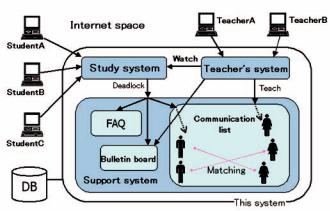
Stimulating Learners Motivation in a Web-Based E-Learning System
Figure 1. System structure
Learning Subsystem
At the beginning, the learner by using the login and password enters the system. Next, he/she reads the text and if understands the text information starts to do the exercises. Then, the obtained results and ranking are shown in the computer display. After that, the learner decides the next items to study and the learning procedure is repeated again. If the learner does not understand some parts of the text, he/she moves to the learner support subsystem. After he/she understands the text, it goes back to the learning subsystem.
Teacher Supporting Subsystem
In this subsystem, the person who is registered as a teacher can enter the system by using the registered login and password. By using this subsystem, the teacher is able to judge the learning situation of the learners. The teacher can check the following items.
•The learners who are using the system.
•The items which are finished.
•The learner study situation (is the learner using the learner supporting system or not).
•The FAQ of the learner support subsystem.
•The Bulletin Board (BB) of the learner support subsystem
If the teacher finds that a student is using the learner support subsystem, the teacher can communicate with the learner by e-mail. It is also possible to communicate with the learner by using Window Messenger (WM). By these communications, the teacher can help the learner if he has problems during the study. By using WM, it is possible to have voice chat or video chat, while BB is used to explain the content that the learners do not understand.
Learner Supporting Subsystem
The learner supporting system is used to help the learners when they have problems during the study. This subsystem includes:
•FAQ,
•BB,
•The list of persons who can communicate together.
The learner can investigates by FAQ whether there are answers of previous questions related with the content that the learner is studying or not. If there are not answers, the learner waits until the
225
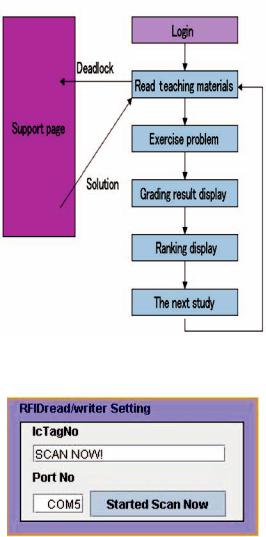
Stimulating Learners Motivation in a Web-Based E-Learning System
answer is shown in the BB. If the learner needs the answer in real time he enters in the member list. Then, the present learner can select a member who answered the questions in the previous test and communicate with him.
Interactive Functions
The proposed system has the following communication modes.
•Communication between students
•Communication between the student and teacher (question mode)
•Communication between the teacher and student (explanation)
Design and Implementation
of New Functions
Here, we present the design and implementation of new functions for our system. The page output is generated by using JSP. For the system logic, we use Java and Java Servlet. For the system database is used Postgresql. The system works in the following way. At the beginning, the learner enters the study room. Next, the learner starts to study the learning materials. The teacher checks the learning situation and based on that decides how to support the learner. By using WM it is possible to have voice chat or video chat.
Also, because the FAQ and learner support subsystem are linked in this page, they can be referred if are needed. The BB can be used by teacher to explain the content that the learners do not understand. If the learner understands the problem he asked the teacher, he goes back to the learning phase and starts again learning process. The e-learning flow is shown in Figure 2. In order to check whether the learner is in the room or not weimplementedaRFIDsystemasshowninFigure 3. The implemented system interface is shown in Figure 4. We will present in the following its new implemented functions.
Figure 2. E-learning flow
Figure 3. RFID checking system
Visible motivation Function
In the previous procedure of the learning, it is very difficult to check the student’s learning situation. For this reason we designed and implemented a newfunction.Ifalearnerdoesnotusethecomputer keyboard or the mouse for more than 20 minutes, it is assumed that he has lost concentration, for this reason the system sends the first alert (Figure 5) and changes the display color in yellow. If the learner still does not use the keyboard or mouse,
226
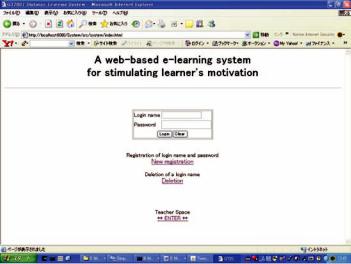
Stimulating Learners Motivation in a Web-Based E-Learning System
Figure 4. System interface
after 10 seconds, the system sends the second alert (Figure 6) and the display is changed in red color. The present learning situation of the learner is checked by the teacher using his Web site as shown in Figure 7. In the left frame of the page are shown the students who are using the system, theirID,learningsituation,SOS(studentsthathave problems with learning materials) and Alert.
Sound Emission Functions
In the case when the learner does not change his behavior, the system emits a relaxing sound to change the mood of learner. Another function is implemented using the cellular phone. We used the sound function of cellular phone to send some music to the learner.
Vibration Functions
In the case when the learner still does not react we considered the vibration function. We realized this function by using the vibration function of the cellular phone. Another implementation was carried out using a motor in the chair. We can control the motor of the chair by our implemented
system as shown in Figure 8. By changing the angle of the motor, the system can change the learner mood.
Room Light Control Function
In our system, we also implemented the room light control function. By this function, we can change the room brightness and stimulate learners to increase the learning efficiency. The snapshot of system is shown in Figure 9.
Smell Function
With this function the system changes the smell of the room based on the learner’s taste (learner’s favorite smell), so the mood of the learners can be changed.
Ranking Function
In the previous system, we used a ranking function that displayed the results of a learner that had average results more than a predefined value. However, this may cause problems if learners have not good results. In proposed system, we
227
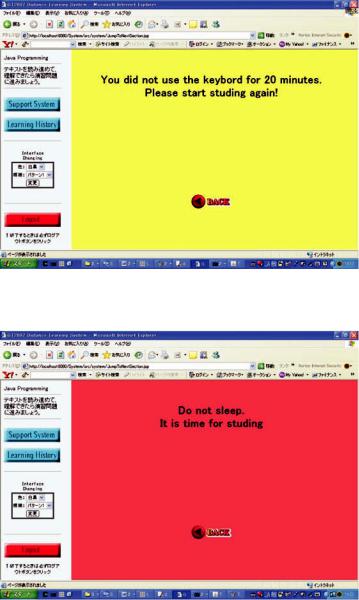
Stimulating Learners Motivation in a Web-Based E-Learning System
Figure 5. First alert
Figure 6. Second alert
implemented a new ranking function as shown in Figure 10.
The ranking method is as follows. We divide the learners in different ranks such asA(90 to 100 points), B (80 to 89 points), C (70 to 79 points), D (60 to 69 points) and E (0 to 59 points). If a learner is ranked inAor B rank, the system shows the other learners who have 10 points more and 5
points less than the present learner. If the learner is ranked in C or D rank, the system shows the other learners that have 5 points more and 5 points less than the present learner. Otherwise, if the learner is ranked in E rank, the system does not display the results. Also, if a learner wants to check his studying situation and history, the system can
228
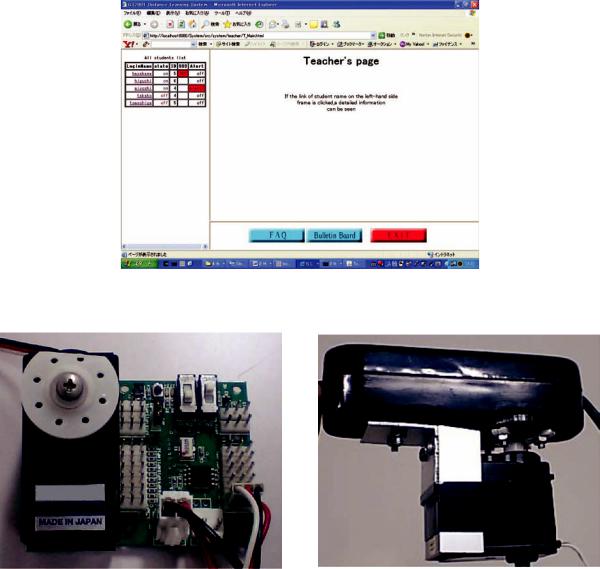
Stimulating Learners Motivation in a Web-Based E-Learning System
Figure 7. Teacher page
Figure 8. Chair motor control |
Figure 9. Room light control |
show the ranking level for each item as shown in Figure 11.
SYSTEm EVALUATION
For experiments we implemented some stimulation devices. The snapshot of RFID and USB experimental devices is shown in Figure 12. IC tag is recognized by the RFID reader and LEDs
connected to the RFID reader by USB will start to blink. Our system identifies the learners by RFID. Also, we controlled USB, RS232C, Motor and RFID by implementing a Java program. The functions and interfaces of our proposed system are shown in Figure 13.
The proposed system can detect the learner’s movement by using hand and body sensors. In our experiments, we used one hand sensor and two body sensors. The hand sensor detects the
229
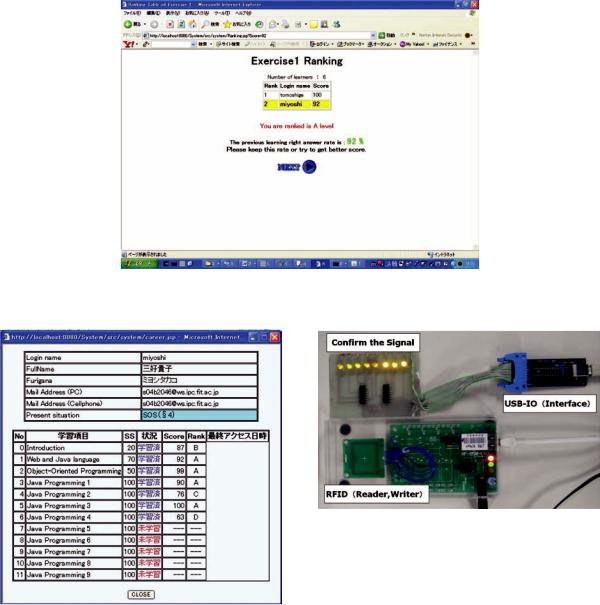
Stimulating Learners Motivation in a Web-Based E-Learning System
Figure 10. Ranking function
Figure 11. Learning history |
Figure 12. RFID and USB devices |
hand motions of the learner, while the body sensors are used for detecting the body movements of the learner. By combining Web and sensor technologies, the proposed system not only can monitor and control the learners’ in the internet but also can stimulate and increase the learners’ motivation. The combination of Web and sensor technologiesisshowninaschematicwayinFigure
14 and “Hand Sensor” and “Body Sensors” are shown in Figure 15.
The measurement data for learners’ body and hand movements are shown in Table 1. We got these data after observing two learners studying for 40 hours. After a sensor reacts, the interval time will be reset to zero. For the “All Sensors”, we make the record of data whenever we get a reaction from either “Hand Sensor” or “Body Sensors”.
We consider where is the point of effective stimulation for learners from the sensing rate values. We pay attention to the reaction frequency
230
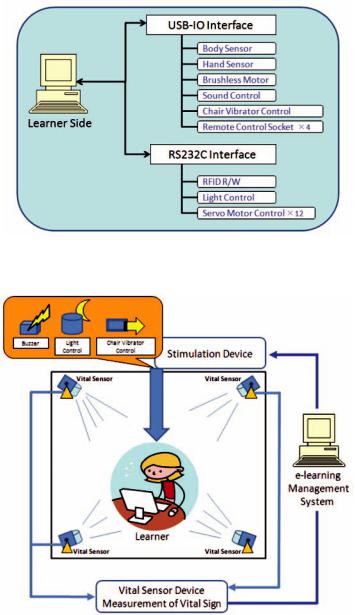
Stimulating Learners Motivation in a Web-Based E-Learning System
Figure 13. Functions and interfaces
Figure 14. Combination of Web and sensors technologies
of each sensor. The interval of sensors response is very active at about 20 to 30 seconds, but it gets less active after 30 seconds. This shows that the learners make certain actions every 30 seconds while they are studying. After 80 seconds, there is almost no reaction for the sensors.
Especially, when we see the response time for “All Sensors” this is very clearly. In Table 2 are shown values of reaction number for “All Sensors”. We can see from Table 1 that the learner’s body moves more than learner’s hand (mouse). We show in Table 3 the sensor response range and the average value of response time. Moreover,
231

Stimulating Learners Motivation in a Web-Based E-Learning System
Figure 15. Hand and body sensors
we can obtain the stimulation point by using the regression analysis.
We used the least square method for obtaining the regression line. The regression line can be expressed by Equation (1).
y = b0 + b1x |
(1) |
In order to construct the regression line, we should calculate b0 and b1 values, but they are
Table 1. Learner’s body and hand movement
very difficult to be calculated. For this reason,
Ù Ù
we will find the expectation values: b0, b1 . First, we find the relation between b0 and b1 shown by Equation (2).
n |
|
l(b0, b1) = å(yi -(b0 + b1x))2 |
(2) |
i=1
The Equation (2) should fulfill the condition of Equation (3).
b |
0 |
min b l(b0, b1) |
(3) |
|
1 |
|
ÙÙ
Then, the b0, b1 values can be calculated by Equations (4) and (5).
bÙ |
|
å(xi - |
|
)(yi - |
|
) |
|
||||||
= |
x |
y |
|
||||||||||
1 |
|
|
|
å(xi - |
|
)2 |
(4) |
||||||
|
x |
||||||||||||
Ù |
|
Ù |
|
|
|
|
|
|
|
|
|
||
b0 |
= |
|
-b1 |
|
|
(5) |
|||||||
y |
x |
||||||||||||
Response Range |
Hand Sensor Sensing Rate |
Body Sensors Sensing Rate |
All Sensors Sensing Rate |
|
|
|
|
0s-10s |
27.31 |
45.60 |
62.39 |
|
|
|
|
10s-20s |
30.63 |
37.61 |
26.55 |
|
|
|
|
20s-30s |
15.27 |
7.94 |
5.47 |
|
|
|
|
30s-40s |
8.52 |
3.20 |
2.23 |
|
|
|
|
40s-50s |
5.90 |
1.43 |
1.04 |
|
|
|
|
50s-60s |
3.95 |
1.11 |
0.77 |
|
|
|
|
60s-70s |
2.65 |
0.64 |
0.41 |
|
|
|
|
70s-80s |
1.67 |
0.58 |
0.27 |
|
|
|
|
80s-90s |
1.13 |
0.29 |
0.20 |
|
|
|
|
90s-100s |
1.09 |
0.29 |
0.23 |
|
|
|
|
100s-110s |
0.61 |
0.26 |
0.09 |
|
|
|
|
110s-120s |
0.27 |
0.26 |
0.07 |
|
|
|
|
120s-130s |
0.24 |
0.24 |
0.14 |
|
|
|
|
130s-140s |
0.40 |
0.21 |
0.05 |
|
|
|
|
140s-150s |
0.24 |
0.19 |
0.07 |
|
|
|
|
150s-160s |
0.12 |
0.13 |
0.02 |
|
|
|
|
232

Stimulating Learners Motivation in a Web-Based E-Learning System
Table 2. Reaction number for “All Sensors”
Response Range |
All Sensors Reaction Number |
Average of Appearance Time (min) |
|
|
|
0s-10s |
2747 |
0.9 |
|
|
|
10s-20s |
1169 |
2.1 |
|
|
|
20s-30s |
241 |
10.0 |
|
|
|
30s-40s |
98 |
24.5 |
|
|
|
40s-50s |
46 |
52.2 |
|
|
|
50s-60s |
34 |
70.6 |
|
|
|
60s-70s |
18 |
133.3 |
|
|
|
70s-80s |
12 |
200.0 |
|
|
|
80s-90s |
9 |
266.7 |
|
|
|
90s-100s |
10 |
240.0 |
|
|
|
100s-110s |
4 |
600.0 |
|
|
|
110s-120s |
3 |
800.0 |
|
|
|
120s-130s |
6 |
400.0 |
|
|
|
130s-140s |
2 |
1200.0 |
|
|
|
140s-150s |
3 |
800.0 |
|
|
|
150s-160s |
1 |
2400.0 |
|
|
|
Total of Data |
4403 |
|
|
|
|
Table 3. Regression line
|
Response Range |
|
|
|
|
|
|
Middle Value [sec] |
Average Response |
Deflection |
Deflection |
Product of |
Value of |
i |
(X) |
Time [min] (Y) |
Value (X) |
Value (Y) |
Deflections |
Regression Line |
|
|
|
|
|
|
|
1 |
5 |
0.9 |
-15 |
-8.5 |
127.1 |
-2.47 |
|
|
|
|
|
|
|
2 |
15 |
2.1 |
-5 |
-7.3 |
36.5 |
5.41 |
|
|
|
|
|
|
|
3 |
25 |
10.0 |
5 |
0.6 |
3.1 |
13.28 |
|
|
|
|
|
|
|
4 |
35 |
24.5 |
15 |
15.1 |
227.2 |
21.16 |
|
|
|
|
|
|
|
The experimental values and regression line are shown in Figure 16. It is proved that in general the people concentration is about 20 minutes. By checking the values of Figure 16, we see that when the response range is about 35 seconds, the value of regression line is about 21.16 minutes. The calculation is done considering that the total experimental time is 40 hours. This value is very close with the region of human concentration (20 minutes). For this reason, we consider that is better to stimulate the learners after 20 minutes in the design of our proposed system.
We considered that is an effective way to stimulate the learner after 35 seconds, 55 seconds and 80 seconds as shown in Figure 17. According to the results of the experiment, we decided that if the learners don’t move for 35 seconds, we would give them a slight stimulation by light, and then after about 55 seconds from the start give them a sound stimulation and then start vibrate their chair after about 80 seconds. We will also give the smell stimulation to learners if they do not respond after more than 100 seconds.
233
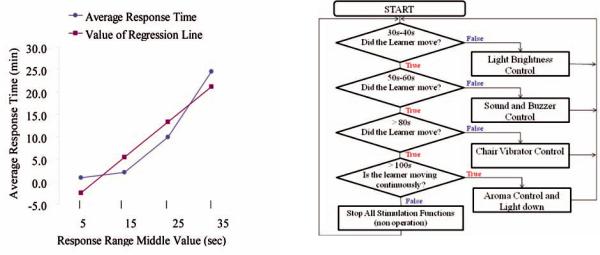
Stimulating Learners Motivation in a Web-Based E-Learning System
Figure 16. Experimental values and regression line |
Figure 17. Flow chart of learner stimulation |
In order to evaluate the proposed system, 10 learners used the system and after that we made a questionnaire and asked the learners how it was the system performance and especially how the system stimulated the learner’s volition?The questionnaire content is shown in Table 4 and the questionnaire results are shown in Table 5.
In the questionnaire, the learners answer the questions by using a five-grade system from 1 to 5. Only Q2 is a threefold choice (Table 4). The performance evaluation is better when the evaluation number is higher. When a learner evaluates with 5, it means that the system had very good performance. The values shown in Table 5 are the average values collected from 10 learners.
Considering the questionnaire results, we conclude that proposed system is an effective system for keeping the learner’s motivation. The “Vibration function” and “Movement” of Q2 has the highest result. These results proved that by giving a directly physical stimulation to learners, the proposed system has a better efficiency than just using the computer display of the previous system. Especially, for the answer of Q2, the evaluation rate is 80% for the question: How you evaluatethedirectlystimulationtolearners?This result also corresponds with the results of Q1.
Therefore, we think that the proposed system is more effective than the previous system. Also, the implementation of RFID has a high evaluation value. We think that we can develop even more effective functions using RFID. However, the evaluation of smell function was low. This is because the learners have different smell tastes. But, we think that by selecting an appropriate taste for each learner, the evaluation for this function will be improved.
COmPARISON EVALUATION
OF E-LEARNING SYSTEmS
We compare the functions of the proposed system with MESIA system and our previous system as shown inTable 6. In the proposed system the same with previous system the BB is used to give the hints by teacher, but in MESIAthe hints are used to advice the learners on wrong answers and HELP/ MORE for guiding learners to correct answers. As test function, MESIA uses a short test, while in our previous system and the proposed system the learner repeats the exercises until he passes the test. For teacher-student interaction, MESIAuses messages, while in our previous system and the
234

Stimulating Learners Motivation in a Web-Based E-Learning System
Table 4. Questionnaire content
Question Number |
Question Content |
|
|
|
|
Q1 |
How much did the “Sound, Light Control, Chair Vibration and Smell function” keep your learning motivation? |
|
|
|
|
Q2 |
How do you evaluate the stimulation by visual, sound and learner’s body movement? Which one do you think is more |
|
effective? [visual and sound, vibration and movement, both] |
||
|
||
Q3 |
How do you evaluate RFID control and management function? |
|
|
|
|
Q4 |
How do you evaluate the e-mail attention function when the learner is not in the room? |
|
|
|
Table 5. Questionnaire results
Question Number |
Performance Results |
|
|
Q1 |
Sound 4.4 / Light 3.1 / Vibration 4.5 / Smell 2.7 |
|
|
Q2 |
Visual, Sound 10% / Movement 80% / Others 10% |
|
|
Q3 |
4.9 |
|
|
Q4 |
4.3 |
|
|
Table 6. Comparison of functions for different systems
Functions |
MESIA |
Previous |
Proposed |
|
System |
System |
|||
|
|
|||
|
|
|
|
|
Hints |
○ |
○ |
○ |
|
|
|
|
|
|
Tests |
○ |
○ |
○ |
|
|
|
|
|
|
Teacher Student |
○ |
○ |
○ |
|
Interaction |
||||
|
|
|
||
|
|
|
|
|
Students Questions |
○ |
○ |
○ |
|
|
|
|
|
|
Network Environ- |
○ |
○ |
○ |
|
ment |
||||
|
|
|
||
|
|
|
|
|
Synchronous |
○ |
○ |
○ |
|
Learning |
||||
|
|
|
||
|
|
|
|
|
Asynchronous |
× |
○ |
○ |
|
Learning |
||||
|
|
|
||
|
|
|
|
|
Ranking Function |
× |
∆ |
○ |
|
|
|
|
|
|
Interface Change |
× |
∆ |
○ |
|
Function |
||||
|
|
|
||
|
|
|
|
|
Vibration Function |
× |
× |
○ |
|
|
|
|
|
|
Sound Emission |
× |
× |
○ |
|
Function |
||||
|
|
|
||
|
|
|
|
|
Room Light |
× |
× |
○ |
|
Control Function |
||||
|
|
|
||
|
|
|
|
|
Smell Function |
× |
× |
○ |
|
|
|
|
|
235
Stimulating Learners Motivation in a Web-Based E-Learning System
proposed system is used e-mail. In the case when a learner wants to ask the teacher a question, in MESIA is used an online message or video meeting. While, in our previous system and proposed system, the teacher answers the student’s question by e-mail or using WM.
TheMESIAisusedintheIntranetenvironment, while the previous system and proposed system are Web-based application and can be used in Internet environment.
In order to have an efficient study, in MESIA the student and the teacher use a synchronous interaction.Theprevious andproposed systemcan be used for synchronous and asynchronous learning. MESIA does not have a function to stimulate the learner’s motivation, while in our previous system has the display of learner’s study history, changeofinterfacecolorinmanualway,encourage function, ranking function, and self-determination of the study materials. Our proposed system has all these functions. We also implemented the following functions: a new ranking function, the automatic interface change function, the vibration function,theroomlightcontrolfunctionandsound emission function.
CONCLUSION
We designed and implemented new functions such as: a new ranking function, automatic interface change function, vibration function, room light control function and sound emission function in order to improve the performance of our Web-based e-learning system. By using these new functions, the proposed e-learning system can increase learner’s efficiency by stimulating learner’s motivation. The experimental results showed that the implemented system has better performance than previous systems.
In the future, we want to evaluate the proposed systemanditsnewfunctionsinarealenvironment. We also want to deal with following problems: learner’s privacy, system security, and improving
the encouraging function by using not only text but also the animations.
REFERENCES
Arizona Regents University. (n.d.). Retrieved from http://www.azun.net/
Barolli, L., & Koyama, A. (2004). A distance learning system for delivering appropriate studying materials and stimulating learner volition.
Journal of Distance Education Technologies,
2(1), 1–17.
Barolli,L.,Koyama,A.,Durresi,A.,&DeMarco,
G. (2006). A Web-based e-learning system for increasing study efficiency by stimulating learner motivation. Journal of Information Systems Frontiers, 8(4), 297–306. doi:10.1007/s10796- 006-9004-5
Barolli, L., & Koyama, K. (2005).AWeb-based distance learning system using cooperative. In
C. Howard, J. Boettcher, L. Justice & K. Schenk
(Eds.), Encyclopedia of distance learning (pp. 430-439).Hershey, PA: Information Science Reference.
Blackboard and WebCT. (n.d.). Retrieved from http://www.black board. com/webct
CALAT Project. (1998). Nippon Telegraph and Telephone Corporation. Retrieved from http:// www. calat.com/.
California Virtual University. (n.d.). Retrieved from http://www.california.edu/.
CALsurf. (2000). NTT Software Corporation. Retrieved from http://webbase.ntts.co.jp/
Campus, K. V. (n.d.). Retrieved from http://www. kcvu.org/
Canadian Virtual University. (n.d.). Retrieved from http://www.cvu-uvc.ca/.
236
Stimulating Learners Motivation in a Web-Based E-Learning System
Globewide Network Academy. (n.d.). Retrieved from http://www.gnacademy.org/.
Indiana University. IU Online and Distance Education. (n.d.). Retrieved from http://www.iu.edu /~iuonline/index.html.
Katayama,K.,&Kambayashi,Y.(1999).Support of distance lectures using active database. Trans. of IEICE, D-I, 82(1), 247–255.
Koyama,A., Barolli, L., Cheng, Z., & Shiratori,
N. (2002). An agent-based personalized distance learning system for delivering appropriate studying materials to learners. ( . LNCS, 2343, 3–16.
Koyama,A., Barolli, L., Tsuda,A., & Cheng, Z.
(2001). An agent-based personalized distance learning system. In Proceedings of ICOIN-15
(pp. 895-899).
Kuwabara, T., Tamaki, M., Yamada, K., Nakamura, Y., Mistunaga, Y., Konishi, N. & Amano,
K. (2000). Support functions for stalled students and their effectinamulti-mediaassistededucation system with individual advance (MESIA). Transactions of IEICE, J83-D-I, 83(9) 1013-1024.
Michigan State University. Virtual University. (n.d.). Retrieved from http://www.vu.msu.edu/ site/
MindEdge. Online Education. (n.d.). Retrieved from http://www.newpromise.com/
Nakabayashi, K., Koike, Y., Maruyama, M.,
Touhei,H.,Fukuhara,Y.,&Nakamura,Y.(1999).
CALCAT: An Intelligent CAI System Using WWW. Trans. of IEICE, D-II, 80(4), 906–914.
Ohio Learning Network. (n.d.). Retrieved from http://www. oln.org/
Oregon’s One-Stop for Distance Education. (2008). Retrieved from http://oregonone.org/
Pennsylvania State University. “World Campus” (2008).Retrieved from http://www.worldcampus. psu.edu/
Tamaki, M., Kuwabara, T., Yamada, K., Nakamura, Y., Mistunaga, Y., Konishi, N., &Amano,
K.(2000).MultimediaAssistedEducationSystem with Individual Student Advance. IPSJ Journal, 41(8), 2351–2362.
The Open University. (2008). Retrieved from http://www.open.ac.uk/
The University ofTheAir. (1984). Retrieved from http://www.u-air.ac.jp/
University of Florida Distance Learning. (2008). Retrieved from http://www.distancelearning.ufl. edu/.
University of Illinois Online. (2008). Retrieved from http://www.online.uillinois.edu/.
University of Wisconsin-Platteville Distance Learning Center. (2008). Retrieved from http:// www.uwplatt. edu/disted/.
WebCAI Courseware System. (1999). Retrieved from Nihon University, http://iclab.ce.nihon-u. ac.jp/~webcai/.
WIDE University, School of Internet. (1997). Retrieved from http://www.sfc.wide.ad.jp/soi/ contents.html.
KEY TERmS AND DEFINITIONS
Computer Interface: The term Computer Interface refers to the way a person experiences the computer, its application programs, hardware components, output devices and functionality.
Distance Learning: Teaching and learning situations in which the instructor and learner (or learners) are geographically separated, and therefore, rely on electronic devices and print material for instructional delivery.
Learning Motivation: There are two types of learning motivation: the internal and external.The former has to do with the learner’s spontaneity and interest, the latter one arises from external factors
237
Stimulating Learners Motivation in a Web-Based E-Learning System
such as competition with the others, rewards, and penalties.
Multimedia: The use of computers to present text, graphics, video, animation, and sound in an integrated way.
Radio-Frequency Identification (RFID):
RFID is the use of an object (typically referred to as an RFID tag) applied to or incorporated into a product, animal, or person for the purpose of identification and tracking using radio waves. Some tags can be read from several meters away and beyond the line of sight of the reader.
Regression Line: A regression line is a line drawn through scatter-plot of two variables. The line is chosen so that it comes as close to the points as possible.
Stimulation Function: Stimulation functions are functions that increase the learner’s motivation and thus increasing learning efficiency.
WWW: Computer network consisting of a collection of internet sites that offer text, graphics, sound and animation resources through the hypertext transfer protocol.
238
